production Strider 24
plywood Romany 34
lightweight 14ft Zeta mainhull
Strike 15 trimaran at speed
28ft Skoota in British Columbia
10ft 2 sheet ply Duo dinghy
24ft Strider sailing fast
36ft Mirage open deck catamaran
- All Our Designs
- For new visitors
- About Richard Woods
- Useful Articles
- Testimonials
- Plan Updates
- Links to Owners and Suppliers
- Consultancy Service
- Boats for Sale
- Blog and Facebook Posts
- Our Cruising Blog (updated Jan 26th 2020)
- Download Eclipse logbook (300 page pdf)
- Download Newsletters 1992-2002 (pdf)
- Download Year Reviews 2002-14 (pdf)
- Download FAQs (pdf)
- Download Boat Tests (pdf)

Keels or Daggerboards, the pros and cons
When writing about foils (ie boards, keels and rudders) it is easy to baffle people by talking about lift to drag ratios, NACA sections, end plates, twist, stall, Karman vortices and all the rest. So I won't - it's probably best to leave all that to designers and hydrodynamacists Instead I'll try to help those who want to know the basics; like should they have keels or boards on their multihull?
I'm not just a multihull designer; I'm also a (home) boatbuilder and owner. Currently I own two catamarans, one with daggerboards and one with keels. Over the last 30 years I have owned five cruising catamarans with keels, nine with daggerboards and one with one centerboard. Furthermore, I am one of the few designers who has fitted LAR keels and boards to the same hull (on Strider, Sagitta and Banshee) and then sailed them against each other.
As with everything to do with yacht design, leeway prevention is a complex subject. And it is not helped by the fact that boats are not just for sailing. You load them down and treat them as a floating cottage when you live aboard them. You motor them, you dry them out (either when the tide goes out or when stored ashore in a boatyard). And you have to pay for it all.
===========================
First a bit of simple theory
The main factor determining the efficiency of a foil is its "Aspect Ratio" (AR) or the ratio of it's depth to width. I think we all know that a high aspect ratio foil is more "efficient" than one with a low aspect ratio. A 3:1 AR is generally considered ideal for rigs but is usually too high for foils. In fact a 1:1 AR is OK for keels, although 2:1 or a bit more is better. In other words, a 1.5m deep daggerboard on a 10m boat will be about 750mm fore/aft (or more properly called it's "chord"). And it will be about 75mm thick, as the thickness of a foil should be about 8-10% of the chord.
Despite the fact that high AR foils are more efficient, there are a couple of reasons for limiting AR. As the AR increases the chord decreases and so the foil becomes thinner and clearly it is then also weaker. Unfortunately the foil loads have gone up (because the deeper the foil the further the Centre of Lateral Resistance (CLR) is from the bottom of the hull, so the lever has lengthened). So long, narrow foils are more prone to damage (one reason all those monohull keels have snapped off - a J800 lost one just recently).
In addition, the higher the AR the easier it is to stall the foil. When a foil stalls it stops "working", this is most obvious after tacking in a sloppy sea and you find that the boat won't sail properly for a couple of boat lengths. That is because the foil has stalled. In other words, you have to be sailing in flat water and be a very attentive helmsman to avoid stalling a high AR foil.
The lower the AR the bigger the foils area has to be to compensate for the reduced efficiency, however a lower AR is more tolerant of shape, surface roughness and angle of attack (which basically makes it easier to sail)
So how big should a foil be? Roughly 4% of the sail area is a good starting point. Some designers use very small boards. That may be OK in theory, which says that you sail in flat water at maximum speed, but in practice I find you need a bigger board to cope with waves and slow sailing, never mind tacking in a lumpy sea.
Whilst on the dangers of too much theory. Many race boats use sophisticated shapes and low drag sections. Don't use them unless, like top racing boats, you also dry sail your boat. Only the simplest shapes work with a rough surface (even new, clean antifouling is considered rough), these fancy shapes need a smooth, ie a mirror finish, to be of benefit.
I definitely don't like asymmetric foils. True they may give a bit more lift but only one can be used at a time, the other HAS to be raised. So you are carrying around the extra weight of a second board and box plus wasting time adjusting boards after each tack which all makes it not worth the very small efficiency gain.
Many people, especially cruisers, don't mind compromising on performance if it means an easier life, more load carrying and greater protection for the rudders and propellers. And that is why Low Aspect Ratio (LAR) keels are so popular. In much the same way as monohull sailors buy a long keel boat rather than one with a fin keel.
Unfortunately, using LAR keels results in a slower boat and more pitching. That is because to optimize speed you need a hull with buoyancy in the ends, not in the middle (technically you need a high Prismatic Coefficient - Cp). Clearly adding a LAR keel adds buoyancy in exactly the wrong place. Furthermore the midships buoyancy makes the boat pitch more as the hull is more "diamond-like". Having said that the buoyancy in the keel adds to total displacement, so you can carry more gear. And you can use the keel as a water tank/shower sump or even somewhere to fit an engine.
As I have just said, a lower AR means having a bigger foil and so clearly a LAR keel has to have much more area than a daggerboard. Thus the wetted surface area (WSA) is significantly increased, especially when sailing offwind compared to a daggerboarded boat with raised boards. And WSA is the prime source of drag at low speeds. So most designers draw a compromise keel which is smaller than strictly needed to balance the sail forces. But these forces must still balance and this can only be done by having a wider sheeting angle. Which in turn means a LAR boat cannot point as high as one with daggerboards.
So all in all boats with LAR keels are slower on all points of sail and in all conditions when compared to a daggerboarded boat. Say 5deg more leeway and 2deg less pointing. Remember it is hard to tell ones real leeway from looking back at the wake as in a seaway the top 2-3ft of water is blown sideways by the wind. So unless the keel is in deep still water you don't notice that you are drifting sideways until you look at the gps.
Further Design Considerations
Boards can be daggerboards (ie adjusted vertically) or centerboards (ie adjusted by rotating). Even though centre boards sometimes fit better into the accommodation layout and can pivot aft without damage when hitting the ground, daggerboards have proven far more popular. Probably because the centerboard pivot bolt often leaks, while it is very difficult to stop the water surging in the case with the board down, and it is easier for "Stuff" to get stuck in the gap between slot and board, thus jamming the board. A centerboard box/centerboard is probably heavier than using daggerboards. And finally it is harder to remove a centerboard for painting/maintenance.
Angled boards actually take up little interior room and can always be incorporated into accommodation dividers - the nav table bulkhead on a Banshee, the hanging locker on a Sagitta, against the hull side on a Merlin for example. More important is that they then don't bang around in a sloppy sea. Providing the board is angled at under 15deg to the vertical I haven't found any disadvantage in using angled boards. Nor have I noticed any difference between boards placed on the inside of the hull and those on the outside. Certainly there is no advantage in having vertical boards fitted on the hull centerline.
Don't use central boards though the bridgedeck. They simply don't work well. The Prout brothers discovered that in 1953 when they fitted a central board on the prototype Shearwater. By 1954 they had fitted boards in the hulls. The Stiletto catamaran started with a central daggerboard but owners quickly found that converting to ones in the hulls improved performance significantly.
The bottom of a LAR keel should be horizontal, otherwise you'll dry out at angle (OK I know that in many areas boats never dry out, but you want your boat level when in a boatyard) Even worse is a keel that is too short as then the boat can fall forward or aft when people move to bow/stern. Clearly dangerous and damaging to crew and boat.
Building Considerations
Boards are heavy, and more expensive than LAR keels, there's nothing one can do about that. To save weight you can make a short board, so that when down the top of the board is below deck level. Daggerboards can be profiled over their full length. But in that case you need to make the board first, and then make the box round the board. So you need to make expensive boards early on during the build.
The alternative is to profile only the below water portion, leaving the rest rectangular. This means the box is also rectangular, so the board can be made after the box. True, there is some extra turbulence when the board is half raised, but you can negate much of that by fitting a profiled cover plate on the outer side. Also I've found that there are less chance of leaks with a rectangular box and more important, weed, twigs etc are less likely to get between board and case and jam the board.
Many people suggest building a "crash box" to absorb any grounding shock. But be warned! I made one once years ago as an experiment on a dinghy. I ran aground and the board moved back into the crash box, exactly as planned. But then jammed - not part of the plan!! I had to capsize to free the board so I could raise it. Hardly practical on a cruising catamaran!
I haven't used a crash box since, relying instead on a very heavy laminate at the back of the box. My reasoning is that the tapered trailing edge of a board is far weaker than the box and so will always fail first. I proved that when hitting an unmarked reef off Nicaragua and we lost about 300mm x 100 mm of board, yet the box itself was undamaged.
Boards are generally made in timber or foam/glass. I prefer plywood over laminated timber as it is easier to profile. Foam boards are attractive in theory, but it is very hard to stop them warping and getting the correct shape without making a mould first is almost impossible. If you do make a mould you have to join the two halves, and remember boards don't just bend they also twist.
If you can, fit LAR keels as late as possible, this keeps the boat nearer the ground during building and saves a lot of ladder climbing.
What about in use?
Unlike boards, LAR keels are very much fit and forget. So there isn't much to say about keels, except to make sure you have a good sacrificial beaching strip and keep it maintained.
It is sensible to lift the lee daggerboard when reaching, as I have found that most breakages are of the lee board as it gets very loaded at speed. However lifting both boards in a big cross sea is not a good idea as that loads the rudders and that, apart from anything else, makes it heavier to steer, so have both boards half down.
Not being able to lift the lee board for half the time is one reason why I don't like using only one board in one hull. Doing so also means the board is much bigger so there are more local loads and of course it is harder to adjust. And it doesn't seem right to have the CLR so far offline. However if you do fit one board don't fit it in the galley hull as that is always heavier than the other hull.
Lifting the lee board to allow the boat to slip sideways is commonly thought a good idea. I'm not convinced. Tank test work has shown that having a deep lee hull actually helps prevent capsizing. That is because the windward hull lifts to a breaking sea, the sea goes under the bridgedeck and hits the lee hull. Because it is deep it is pushed sideways, which dissipates any overturning energy.
People often think you need a long keel (monohull or multihull) to steer straight "hands off". That simply isn't true. Good directional stability depends on the hull balance. A properly designed daggerboarded boat will sail as straight as a LAR keel one, and have the additional benefit of being quicker to tack and maneuver when necessary.
Finally, if you run aground, you can lift the boards to get off, but remain stuck with keels.
If you don't ever expect to race then keels are OK
If you think crosscut Dacron sails are good enough then keels are OK
If you trail your boat regularly fit dagger boards
If you have wheel steering and inboard engines and expect to dry out often fit keels
If you want the best performance then fit dagger boards, but be prepared to use them

Do Catamarans Have Keels? Uncovering the Truth

Have you ever wondered what makes a catamaran so different from other types of boats? You may have noticed that a catamaran appears to lack the long, central keel that other boats have.
So, do catamarans have keels? In this article, we’ll go beyond the surface level to uncover the truth about catamarans and keels.
We’ll look at what a catamaran is, what a keel is, and why catamarans don’t have keels.
We’ll explore the advantages and disadvantages of not having a keel, as well as the different types of catamarans and their popular uses.
By the end of this article, you’ll have a better understanding of why catamarans are the way they are.
Table of Contents
Short Answer
Catamarans typically do not have keels.
Instead, they have two hulls, or parallel hulls, connected by a frame.
This design reduces drag and increases stability, allowing catamarans to move quickly and remain upright in rough seas .
Keels are typically seen on monohull boats, which are boats with a single hull.
What is a Catamaran?
A catamaran is a type of boat that is made up of two hulls, or parts, that are connected by crossbeams and struts.
Compared to single-hulled boats, catamarans are more stable and provide greater stability due to the weight being distributed over a larger surface area.
This design also allows catamarans to be more easily maneuvered and to move through shallow waters.
As a result, they are often used for recreational activities such as fishing and sailing.
Catamarans also typically lack a keel, which is a fin-like structure that is found on the bottom of a single-hulled boat that helps provide stability and also helps protect the boat from waves or other environmental forces.
Instead, catamarans rely on their two hulls to provide stability and protection.
What is a Keel?

When it comes to boats, the keel is perhaps one of the most important components.
A keel is a long, heavy, and usually flat piece of metal, wood, or fiberglass that is attached to the hull of a boat and extends below the surface of the water.
This structure serves several important functions, including providing stability, generating lift, and helping to steer the boat.
The keel also serves as a counterweight to the wind and wave forces that push against the hull of the boat.
It also helps to disperse the weight of the boat, allowing it to remain level in the water.
While a keel is present on most traditional boats, it is not present on catamarans.
Why Don’t Catamarans Have Keels?
When it comes to boats, the keel is an integral part of the design.
It provides stability and helps the boat to move through the water.
So why dont catamarans have keels? The simple answer is that they dont need them.
Catamarans are designed with two hulls that are connected by crossbeams and struts.
This design helps to provide greater stability by distributing the weight of the boat over a larger surface area.
The lack of a keel also allows the catamaran to be more easily maneuvered and to move through shallow waters.
This design also allows catamarans to be more fuel efficient than traditional single-hulled boats, as the two hulls help to reduce drag.
Additionally, the lack of a keel reduces the overall weight of the boat, making it easier to transport and launch.
The design of the catamaran also helps to make it more stable in rough seas, making it an ideal choice for recreational activities such as fishing and sailing.
The design of the catamaran also allows it to be more responsive to the waves and wind than traditional single-hulled boats, as the two hulls move independently and respond to the conditions more quickly.
This makes them ideal for sailing and other activities, as they are able to turn faster and more accurately than single-hulled boats.
In short, the lack of a keel on catamarans is one of the main advantages of the design.
The two hulls provide greater stability and maneuverability, and the overall lighter weight of the boat makes it easier to transport and launch.
The lack of a keel also makes the catamaran more fuel efficient and responsive to the waves and wind.
As a result, catamarans are often used in recreational activities such as fishing and sailing.
Advantages of Not Having a Keel

The absence of a keel on catamarans can be advantageous in many ways.
First, it provides greater stability than traditional single-hulled boats.
Because the weight of the boat is distributed over a larger surface area, the catamaran’s two hulls are able to withstand more force from waves and other conditions.
This makes them an ideal choice for recreational activities, such as fishing and sailing, as they are able to remain steady in choppy waters.
Furthermore, the lack of a keel allows catamarans to be more maneuverable than single-hulled boats.
Without the additional weight of a keel, catamarans can turn more quickly and easily, making them ideal for racing and navigating through tight spaces.
Additionally, the absence of a keel allows catamarans to move through shallow waters, which is beneficial for exploring areas that would be inaccessible to single-hulled boats.
Lastly, the absence of a keel also contributes to the overall design of the catamaran, as the two hulls are connected by crossbeams and struts.
This design helps to increase stability and reduce rolling.
Additionally, it can provide greater visibility, as the two hulls can extend farther out from the center of the boat, providing a better view of the surroundings.
Disadvantages of Not Having a Keel
The lack of a keel on catamarans can be both a blessing and a curse.
While having two hulls instead of one provides greater stability, this also means that the catamaran is more vulnerable to strong winds and choppy waters.
Without the keel acting as a counterbalance, the catamaran can be more easily pushed off course.
This is especially true if the boat is not well-balanced, as the weight distribution is less evenly distributed without a keel.
Additionally, a keel can provide additional lift to the boat, which can help to increase speed and maneuverability.
Without a keel, catamarans will often be slower and less responsive than a traditional single-hulled boat.
Finally, the lack of a keel also means that the catamaran is more vulnerable to capsizing, as the boat is more top-heavy without the keel acting as a counterbalance.
Different Types of Catamarans

When it comes to catamarans, there are several types that have different designs and features.
The most common type of catamaran is the pontoon catamaran, which is composed of two hulls that are connected with beams and struts.
This type of catamaran is often used for recreational activities, such as fishing and sailing, because of its stability and ability to maneuver in shallow waters.
Another type of catamaran is the trimaran, which is composed of three hulls connected by beams and struts.
The trimaran is designed to provide more stability than the pontoon catamaran, and is often used for racing and long-distance sailing.
The third type of catamaran is the hydrofoil catamaran, which is composed of two hulls that are connected with beams and struts.
This type of catamaran is designed to reduce drag and increase speed by using hydrofoils to lift the hulls out of the water.
This type of catamaran is often used in high speed boat racing and can reach speeds of up to 40 knots.
Finally, there is the semi-submersible catamaran, which is designed to be partially submerged in water.
This type of catamaran is often used for research and exploration, and can be used to explore shallow waters where traditional boats are not able to go.
No matter the type of catamaran, they all have one thing in common: they do not have a keel. Instead, they are designed with two or more hulls that are connected by crossbeams and struts. This design helps to provide greater stability and allows catamarans to be more easily maneuvered in shallow waters. As a result, catamarans are often used in recreational activities, such as fishing and sailing.
Popular Uses for Catamarans
Catamarans are popularly used in recreational activities such as sailing, fishing, and even racing.
Their unique design allows them to maneuver easily in shallow waters, which makes them ideal for these activities.
Additionally, catamarans are often used for chartering and cruising, as they are more stable than traditional single-hulled boats.
The lack of a keel also allows catamarans to move more quickly through the water.
Furthermore, the spacious living area provided by the two hulls makes catamarans an ideal choice for extended trips and vacations.
Catamarans are also used in commercial activities such as ferrying, transport, and research.
Their stability makes them perfect for transporting cargo and passengers over long distances.
Additionally, the two hulls provide more room for researchers to conduct experiments and surveys.
The shallow draft of catamarans also allows them to navigate shallow waters, which makes them ideal for research purposes.
Lastly, catamarans are also used in rescue and emergency operations, as their stability makes them perfect for difficult and dangerous conditions.
Final Thoughts
In conclusion, catamarans are unique boats that are designed without a keel for added stability and maneuverability.
While they do not have the same advantages as a single-hulled boat with a keel, they are popularly used for recreational activities such as fishing and sailing.
With the knowledge of why catamarans do not have keels, you can now confidently choose the right boat for your next adventure.
James Frami
At the age of 15, he and four other friends from his neighborhood constructed their first boat. He has been sailing for almost 30 years and has a wealth of knowledge that he wants to share with others.
Recent Posts
When Was Banana Boat Song Released? (HISTORICAL INSIGHTS)
The "Banana Boat Song" was released in 1956 by Harry Belafonte. This calypso-style song, also known as "Day-O," became a huge hit and remains popular to this day for its catchy tune and upbeat...
How to Make Banana Boat Smoothie King? (DELICIOUS RECIPE REVEALED)
To make a Banana Boat Smoothie King smoothie at home, start by gathering the ingredients: a ripe banana, peanut butter, chocolate protein powder, almond milk, and ice. Blend the banana, a scoop of...

Sailboat Keel Types: A Complete Guide

Last Updated by
Daniel Wade
June 15, 2022
A keel is a very important part of a sailboat, crucial to its stability and ability to sail upwind. This article will discuss the fundamentals of all keels down to the details of the best keel for your boat. We will answer questions including what it does, what it's made of, and even some problems that a keel can cause. By the end of this article, you will be an expert on all things keels!
Table of contents
What Is a Keel?
A keel is the robust underwater centerline of a boat, and often extends into a long, hydrodynamically shaped blade.. It can vary in size and shape depending on the make and model of the boat. But, generally, it will look very much like a fin. If you imagine the fin on the underside of a surfboard you will have a pretty good idea of what it looks like under the boat.
It is crucial to helping with steering and control. The word keel itself comes from Norse and Dutch roots. The word simply means a structural component of the boat. You may have heard the term keel-haul, where pirates would drag someone underneath the boat across its keel. This is pretty barbaric, but it shows just how long a keel has been an important part of the boat. From Vikings to pirates to modern sailboats it has always remained an important part of a sailboat.
What is a keel made of?
A keel will typically be made of whatever the rest of the hull is made of. If the boat is wooden, it will most likely have a wooden keel. If the boat is metal, the keel will be metal, and so on. Sometimes, particularly on fiberglass boats, the core of a keel will be reinforced with lead or a similar ballast while the outside is covered with fiberglass.
The keel needs to be strong enough to withstand a lot of pressure and strain. Traditionally Viking sailing boats would have a wooden keel with some metal plating on it. Casting metal was tedious so putting it on your boat was seen as a waste. Traditional wooden sailing boats, like you would imagine pirates sailing, would also have a wooden keel. It would be made from thick hardwood like oak and could also be metal plated.
Since it is used to control the direction it must brunt the force of the change of direction. If you imagine a boat turning sharply, there will be a lot of pressure on the side that is on the outside of the turn. The hull of your boat will stand up to this pressure easily, as it is very large and very strong. The keel must be strong enough to withstand this too. The keel also can drag on the ocean floor or the boat ramp as the boat is lowered into the water. For this reason, it needs to be strong enough to hold up to the weight and pressure of the boat too. If it were made of plastic it would break every time you brought the boat in and out of the water.
What does a keel do?
The keel is there primarily for stability and guidance. The keel provides all sorts of benefits to the boat. It improves the righting moment and controls the boat’s sideways movement. The keel will also typically hold the boat’s ballast. The ballast keeps the boat weighed down and helps prevent capsizing. The ballast is typically made of lead, sand, or water.
Keels can be fixed or moveable. Some keels can be removed completely or may just retract slightly so they aren’t damaged when the boat enters or exits the water. When a boat leans to one side, because it is turning or there is strong wind/waves, the keel provides the righting moment that keeps the boat from flipping. On larger boats, it is designed to be so heavy that ig will be able to recover a boat from almost any angle of heel. Without a keel, your boat may tip too far or roll completely. On bigger ships, this can be disastrous. In its ability to prevent this alone, the keel is one of the most important parts of the ship.
Does my sailboat need a keel?
Yes, you do need a keel. Pretty much all sailboats have a keel, with exceptions for multi-hulled and/or smaller boats.
In the case of catamarans, the very design principles that lead to the dual-hull design render the keel obsolete. The stability introduced by the outrigged, dual-hulls replaces the necessary righting moment from the keel. Because almost all the structure of a catamaran is between the two hulls, unlike a monohull which builds out from and around its centerline, there is not a lot of weight pressing out to flip the boat. Related to this, since most catamarans have the length of their hulls pressing into the water, the steering force normally placed on a keel is distributed across the length of the two hulls, which additionally will carry their own ballast.
On smaller dinghies, a small swinging centerboard or daggerboard will suffice to play the role of a keel. The centerboards can be big enough to keep the boat flowing nicely through the water without the need for a large keel. Additionally, it is not a disaster for a small sailing or racing dinghy to capsize, as they are designed to do so and recover rather easily, so the ballast from the keel is also not terribly necessary.
If you have a motorboat you wouldn’t need a keel, unless it is a very large container ship or military vessel. The reason being that they are outboard propelled. The leg provides enough stability on its own. This is only the case with full plane powerboats. Displacement (even semi-displacement) craft will still need a keel of sorts for stability purposes.
What are some downsides to having a longer keel?
If you have a long keel that doesn’t retract or detach, you may have some problems coming in or out of the water. The keel extends far below the bottom of the boat, so if you are bringing your boat up or down a boat ramp you may find that it scrapes on the bottom. If you are not careful, you may damage the keel rather badly.
Since the keel is made of metal, wood, or fiberglass it can bear the brunt of the weight quite well. If you are putting your boat in the water and cannot retract the keel, it is a good idea to go as far into the water as possible before taking your boat off its trailer. The deeper you are in the water when the boat is released the better.
Are there any nautical traditions about the keel of the boat?
The keel is interestingly very important when it comes to boat or shipbuilding.
Traditionally, the keel is one of the first parts of the ship to be made, as the rest of the ship must sometimes be built around it. This tradition is called “laying the keel,” and is a momentous occasion. It is essentially the boat’s birthday. The boat’s age is dated from this moment, and there is also typically a celebration of sorts. This goes back to the days of seafaring exploration. The only day more important in a boat’s life is the day it is finally launched.
Can other types of boats have keels?
Yes! Many other types of boats have keels, not just sailboats. A good example would be a big shipping trawler. These trawlers are very large and need all the help they can get to stay balanced. Because of this, they often have what’s called a bar keel. This is a large rectangular piece of metal that runs along the bottom of the boat’s hull. It is very thick and heavy. The idea is that it gives the boat some more directional control when steering.
Furthermore, it helps keep the trawler balanced when out at sea in rough conditions. The extra weight keeps the boat’s center of gravity as low as possible. This makes tipping the boat almost impossible. It does slow it down a bit, but that is a small price to pay for increased safety.
Huge cargo ships also have a keel, though it is different from a bar. Their keel is known as a plate keel. It is essentially another layer of the boat under the hull. Its only purpose is added weight and protection. A plate keel runs along the centreline of the bottom plate of the ship so the weight is all concentrated in the lowest place possible. This kind of keel works similarly to how the spine of a person does. It keeps your back strong and as straight as possible.
How important is it to keep my keel clean?
It is very important to keep your keel clean, just as it is important to keep the rest of your hull clean.
For any boat kept on the water rather than hauled out every day, there is always the need to clean the hulls and keels of any barnacles and other sea growth. Barnacles not only affect your performance, but can, in the long run, greatly increase your maintenance costs if not regularly addressed.
To do so, you have to do what is known as scraping. Scraping is the process of physically scraping off all the barnacles and other sea life that has attached itself to the underside of your boat. Many marinas offer this service, but you can do it on your own with a basic plastic paint scraper and a wetsuit. When you do this, it is key to get all the way down to the bottom of the keel and all across the hull. If you don’t scrape it off, it can start to erode your boat away over time. It can also slow you down.The barnacles and other marine life create a very rough bottom. This creates more friction and will reduce your speed more and more the worse it gets.
It is important to check with your port authority before you start scraping. Scraping is not allowed in some places as you may introduce invasive species to the area. It depends where you have been more than where you are. If you sailed from New York to Chicago, you will be fine. If you sailed from Cuba to New York, probably not so much.
How to maintain a sailboat keel
As mentioned above, it is important to scrape your keel from time to time. While racing boats will actually do this before every day at an event, it is at least a good idea for you to do this a couple of times a season. A great time to do this is when you plan on applying that season’s bottom paint, though anytime you plan to go on your boat is a good excuse to maintain!
You may want to cut off any of the kelp and seaweed that wraps itself around the keel. This is more likely to happen if you have a fin keel. If you do find that there is a lot of kelp and seaweed wrapped around it, you will want to buy yourself a kelp cutter. Unfortunately, the only way to cut the kelp off without taking the boat out of the water is to dive in and do it yourself. It is a good idea to do this in shallow-ish water with the proper flags displayed to inform other boaters that there is someone in the water. Swimming around under your boat, even when it isn’t moving, can be dangerous.
What do I do if my keel breaks at sea?
It is very rare for keels to just break off. It is even rarer at sea. After all, what is going to break it off? The only way a keel will break off ordinarily is if you run aground.
If you should accidentally make your way into shallow waters and break your keel off it is a good idea to set sail for home. You will manage well enough in the short term but will struggle over time. You are far more likely to capsize without the keel keeping you balanced.
If you have a detachable keel it is a good idea to keep a replacement. If one breaks off, you can just install the spare one. This isn’t the easiest thing to do at sea in rough conditions, but it is possible. Make a judgment call using your common sense whether it is worth the risk or not.
Another reason your keel might break or come loose is if the keel bolts come out. These bolts are what holds the keel in place. If you happen to have a keel held on by bolts, then doing proper maintenance is even more important. If the bolts come loose, the keel can come loose.
Since the keel is typically welded on to the boat’s hull the chances of it coming off completely are slim to none. Most often, running aground on a sandbar or anything short of an incredibly rocky bottom in heavy weather will crack off a piece or severely bend the keel, which requires a major repair. If you do notice that the keel is loose, you are better off taking it back to the marina. The bolts may not come off without using some machinery, meaning you might have to take your boat out of the water. If your keel starts to rust, you may need to speak to a professional.
What are the different keel types?
Now you know what a keel is, what it does, why it is important, and how to care for one it is time to learn about the specific types of keels. Big trawlers and cargo ships have bar or plate keels, but sailboats do not. Here are the 6 different types of keels typically found on sailboats and their purposes:
The full keel is one of the most common types of the keel that you are likely to see on a sailboat. A full keel runs from end to end of the boat lengthways. A full keel, as the name implies, runs almost the entire length of the boat. At a minimum, it must run 50% of the length of the boat. A full keel is one of the most stable keel types, which is why it is so common. Full keels are also safer should you run aground. If a boat with a full keel should come ashore, it will cut its way through the sand and eventually land on its side. Whether you are grounding your boat intentionally or not, your boat will have far better odds of surviving the ordeal with a full keel.
A fin keel is similar to a full keel, just shorter. There may be one or two fin keels along the length of the boat hull. A fin keel is defined by being less than 50% the length of the boat. The fin keel works almost entirely the same way that a shark's fin does. When you wish to turn, the keel provides the resistive force that keeps you turning. This means that it essentially acts as your tires going into a turn. Whereas a full keel is essentially just a long fin, a fin keel has very different benefits. A full keel is more stable and safer overall. A fin keel is sleeker, smaller, and most importantly makes you faster. Most racing sailboats have fin keels.
A bulbed keel is very similar to a fin keel. In fact, it is possible to make a bulb keel by shaving off part of a fin keel and attaching a bulb. Once the keel has been made substantially shorter, the bulb is fitted. The bulb is shaped similarly to how a torpedo would be on a submarine. This keel works the same as a fin keel does, offering a slightly more stability without sacrificing speed. The biggest difference between a bulb and a fin keel (besides shape and length) is where they are used. Bulb keels are most commonly used in places with very shallow waters and lots of rock/shale/coral outcrops. Somewhere like the Caribbean would be the perfect place for a bulb keel. The rounded bulb bounces off the rocks and is less likely to break off. It just isn’t going to be as quick as if you used a fin keel.
The wing keel is another alternative to your standard fin keel. Just like the bulb keel, a wing keel is an extension to the standard fin keel with an extra fitting at the bottom. A wing keel is far more streamlined than a bulbed one, at the expense of being more susceptible to breaking. A wing keel looks very similar to the tail of an airplane. It works the same way, too. The water can pass by either side of the wings, allowing you to adjust your course easily. But, a wing keel does have one major problem. If you do run aground, digging out a wing keel can be very difficult. Whereas digging out a standard fin is as simple as scraping sand away from the sides of it, a wing keel must be dug out completely. The wings act like little shovels and wedge themselves into the sand. These are generally limited to higher performance racing classes.
Centerboard Keel
A centerboard keel works similarly to a fin keel but it can retract slightly. It works by having a dagger that folds out downwards. When you are sailing, the dagger protrudes outwards and offers you all the stability and balance of a fin keel. When you are in shallow water, the dagger can be retracted upwards, essentially shortening the keel temporarily. This should be done when you are sailing in shallow waters or removing the boat from the water entirely using a boat ramp. Some centerboards work on a loose hinge. When the boat is sailing along, the dagger is out and the fin works as normal. If you should bump into something though, like some shallow rocks, the hinge would push the daggerboard back inside. This stops the keel from breaking, instead, it just moves out the way. This only works if you are only just deep enough. If you are in very shallow water you would just break the centerboard off.
Canting Keel
A canting keel also works on a hinge. Instead of working end to end, it works port to starboard. When the boat turns a corner, the canting keel swings from side to side. This allows the boat to maximize its balance and speed. Eventually, this will become the norm in racing. But at the moment it is still quite experimental. The biggest downside is that the hinge works on hydraulics, and hydraulics can fail. If they should fail at sea there is very little you can do to repair them. Once they have perfected these canting keels, they will move first into the racing classes and high performance boats, then to all new cruising boats as boatbuilders improve the technology. .
Hopefully, you now have a good idea about what a sailboat keel is,how it works, why it is so important, and, of course, all the different types. Chances are, when you buy a sailboat , the keel it has is going to be at the bottom of your list of priorities. That being said, if you are planning on sailing somewhere in particular, it is a good idea to think about what keel type you are using. Replacing them doesn’t have to be expensive, but you can go a long way to saving yourself that money either way by being prepared for your home waters!
Related Articles
I've personally had thousands of questions about sailing and sailboats over the years. As I learn and experience sailing, and the community, I share the answers that work and make sense to me, here on Life of Sailing.
by this author
Learn About Sailboats
Most Recent

What Does "Sailing By The Lee" Mean?
October 3, 2023

The Best Sailing Schools And Programs: Reviews & Ratings
September 26, 2023
Important Legal Info
Lifeofsailing.com is a participant in the Amazon Services LLC Associates Program, an affiliate advertising program designed to provide a means for sites to earn advertising fees by advertising and linking to Amazon. This site also participates in other affiliate programs and is compensated for referring traffic and business to these companies.
Similar Posts

Affordable Sailboats You Can Build at Home
September 13, 2023

Best Small Sailboat Ornaments
September 12, 2023

Discover the Magic of Hydrofoil Sailboats
December 11, 2023
Popular Posts

Best Liveaboard Catamaran Sailboats
December 28, 2023

Can a Novice Sail Around the World?
Elizabeth O'Malley

4 Best Electric Outboard Motors

How Long Did It Take The Vikings To Sail To England?

10 Best Sailboat Brands (And Why)
December 20, 2023

7 Best Places To Liveaboard A Sailboat
Get the best sailing content.
Top Rated Posts
Lifeofsailing.com is a participant in the Amazon Services LLC Associates Program, an affiliate advertising program designed to provide a means for sites to earn advertising fees by advertising and linking to Amazon. This site also participates in other affiliate programs and is compensated for referring traffic and business to these companies. (866) 342-SAIL
© 2024 Life of Sailing Email: [email protected] Address: 11816 Inwood Rd #3024 Dallas, TX 75244 Disclaimer Privacy Policy
Sailboat Keel Types: Illustrated Guide (Bilge, Fin, Full)
The keel type is one of the most important features of your boat. But the different designs can be confusing, so I've set out to create a very clear guide that will help you understand sailboat keels once and for all.
What are the most common sailboat keel types? The most common sailboat keel types are full-length keels, fin keels, bulb keels, wing keels, bilge keels, and lifting keels. Full keels are popular among cruisers, while fin keels are generally used for racing. Bilge keels and lifting keels are typically used in tidal waters, on small fishing boats for example.
In this article, we'll explore the most common keel types together. I'll use diagrams to really hit home the differences of all these keel types, and we'll discuss what keel types are best for liveaboard, ocean cruising, and lake weekend trips. After reading this article, you'll know what to choose - and why.
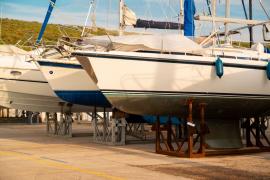
Sailboat Keels Explained
On this page:, overview of sailboat keel types, keel types: fundamentals, modified full keel, centerboard.
If you just want a quick overview, here's a list with the most common keel types and a short description. More detail will follow below.
The most common keel types
- Full keels run from front to aft and are the most stable keel type, making them the most popular cruising keel.
- Fin keels offer the best performance but are less comfortable. This makes them popular for racing. Fin keels are bolted on to the hull and generally run deep and thin.
- Bulb and wing keels are both variants on the fin keel.
- Bulb keels carry additional ballast in the tip, making them more stable.
- Wing keels have two tips at the end of the keel, which reduces crossflow, improving directional stability.
- Bilge keels are double fin or double full kees, which allows the boat to be beached, making them the most popular keel for tidal waters.
- Lifting keels are moveable keels that can be lowered and raised, allowing the boat to enter shallow waters as well.
- Centerboard keels are a pivoting lifting keel, allowing to sail both coastal and inland waters.
- Leeboards are fins on the sides of flat-bottomed hulls boats, making a keel unnecessary.
Properties of each keel type
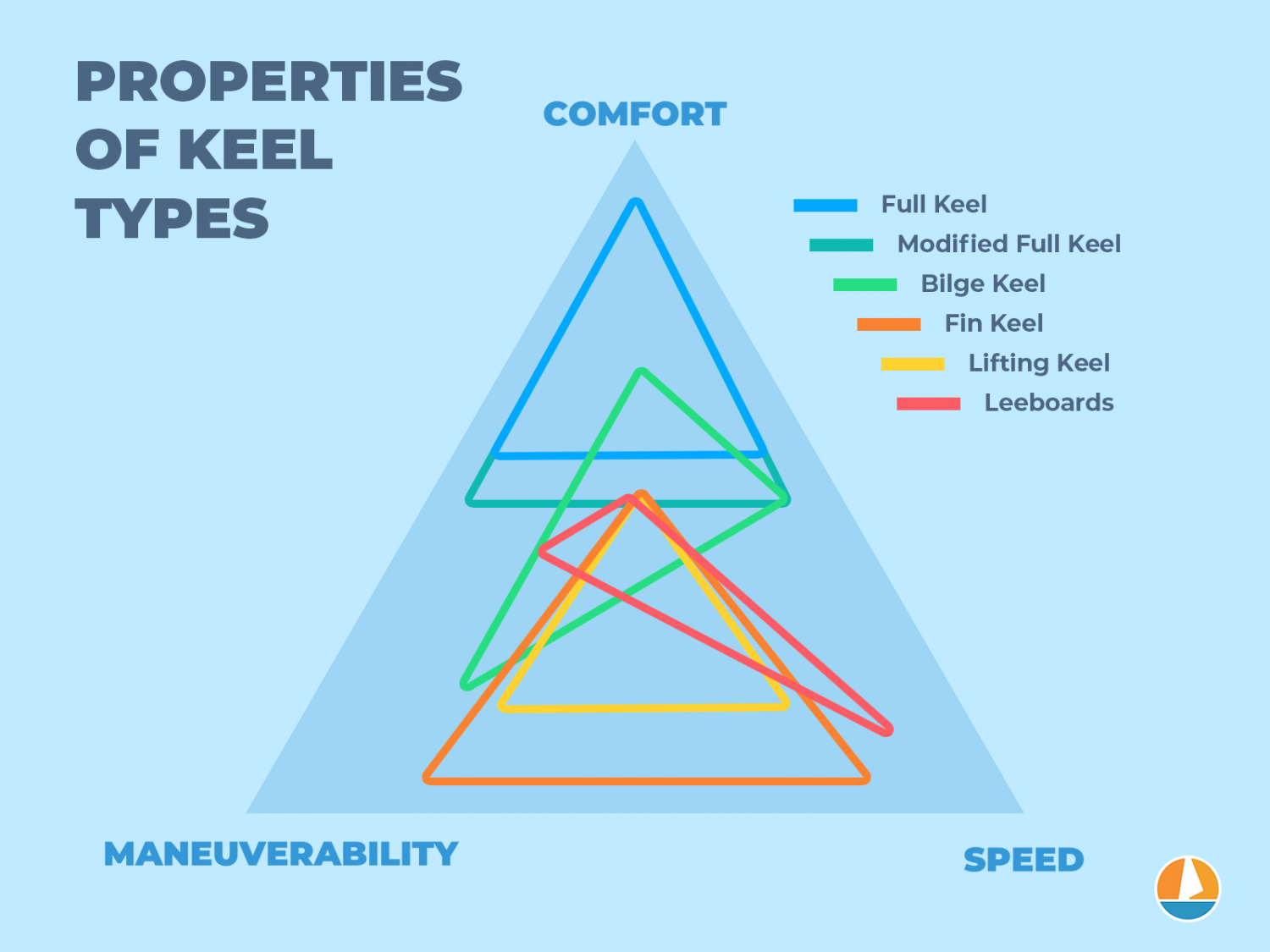
What does a keel do?
What does the keel do? A keel is a vertical blade running down from the hull. It is weighted and acts as a ballast, countering the boat's tendency to heel and preventing it from tipping over. The wetted surface under the waterline reduces slippage to leeward by creating a track, which counters the sideway force of the wind on the sails.
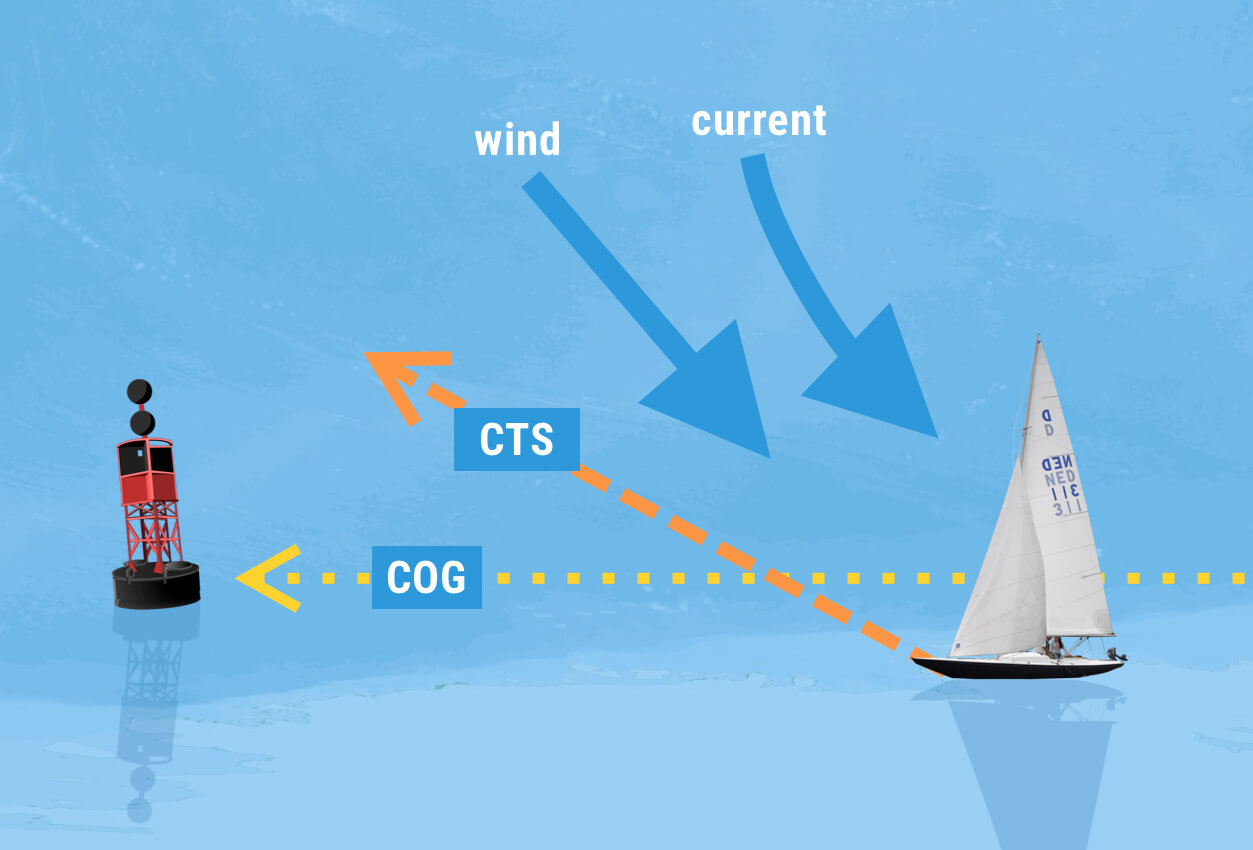
The reason sailboats don't tip over is that the weight of the keel counters the buoyancy of the hull, which means it will pull the boat downward. This downward force reduces heel and prevents the boat from rolling.
A canoe doesn't have a keel. Try stepping into that: it will want to roll.
It counters the horizontal force the wind puts on the sails. Whenever the force on the sails increases, the resistance of the water on the keel increases proportionally.
The heavier the keel, the less heel you'll get.
A keel reduces slippage to leeward. Slippage is simply the amount you fall off course because of the direction of the wind and current. Leeward is the side of the boat behind the wind.
So if you don't have a keel, you will fall off course quite a lot because the wind will push you over the water surface.
You will also heel quite a lot since there is nothing beneath the water surface to counter the force of the wind high up in your sails.
A keel fixes both of these issues and makes sailboats one of the most reliable boats in heavy winds and storms.
You can read on about how keels work here.
Keels can be classified by multiple dimensions. You can look at them from the side or the front. You can also classify them based on properties.
Before I dive into each keel type in-depth and show examples, let's make sure we have the same starting point.
There are essentially two sorts of keels:
Fixed keels
Movable keels.
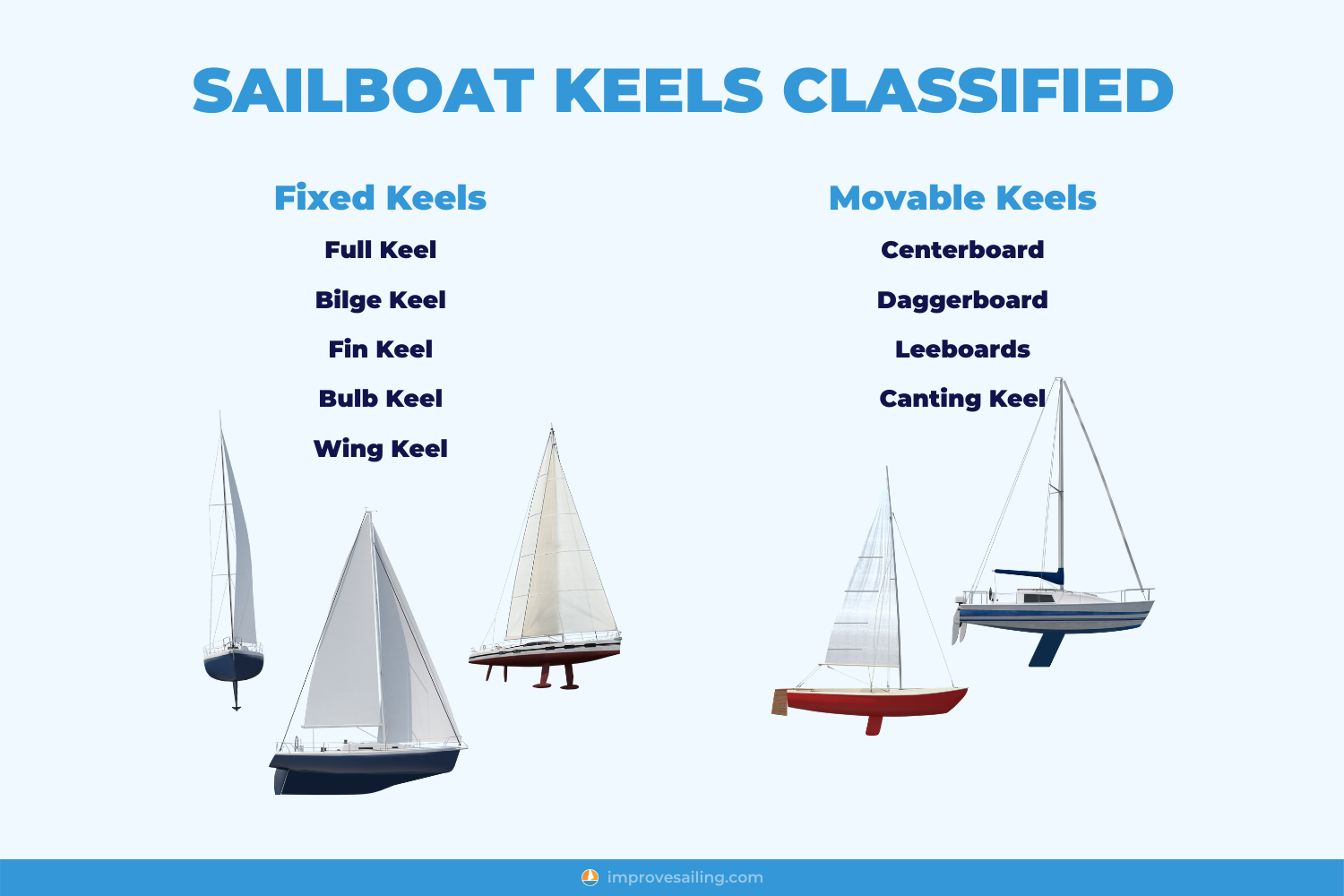
Fixed keels are keels that are integrated into the hull or bolted on. They can't be moved or lifted.
When looking at fixed keels, you can divide them up further based on the side view. There are three main categories:
Bilge keels
Full keels are more comfortable, provide better stability and protection, but are also slower than fin keels.
Fin keels are less comfortable, provide less stability, are more vulnerable, but they're also a lot faster than full keels.
Bilge keels are double keels: one on each side of the hull. This allows them to be beached, which comes in handy in tidal waters. They are generally a lot slower and less maneuverable compared to fin keels.
Movable keels can be lifted from the water, creating a shoal (shallow) draft, allowing the boat to enter both shallow waters and coastal waters. This makes it a very versatile keel type. There are two main designs:
Lifting keels
Lifting keels can be lowered and raised through a slit in the hull. Examples of lifting keels are the daggerboard and centerboard.
Leeboards are wooden swords attached to the side of the hull and prevent slippage to leeward, but they don't stabilize the boat, nor counter heel by adding ballast.
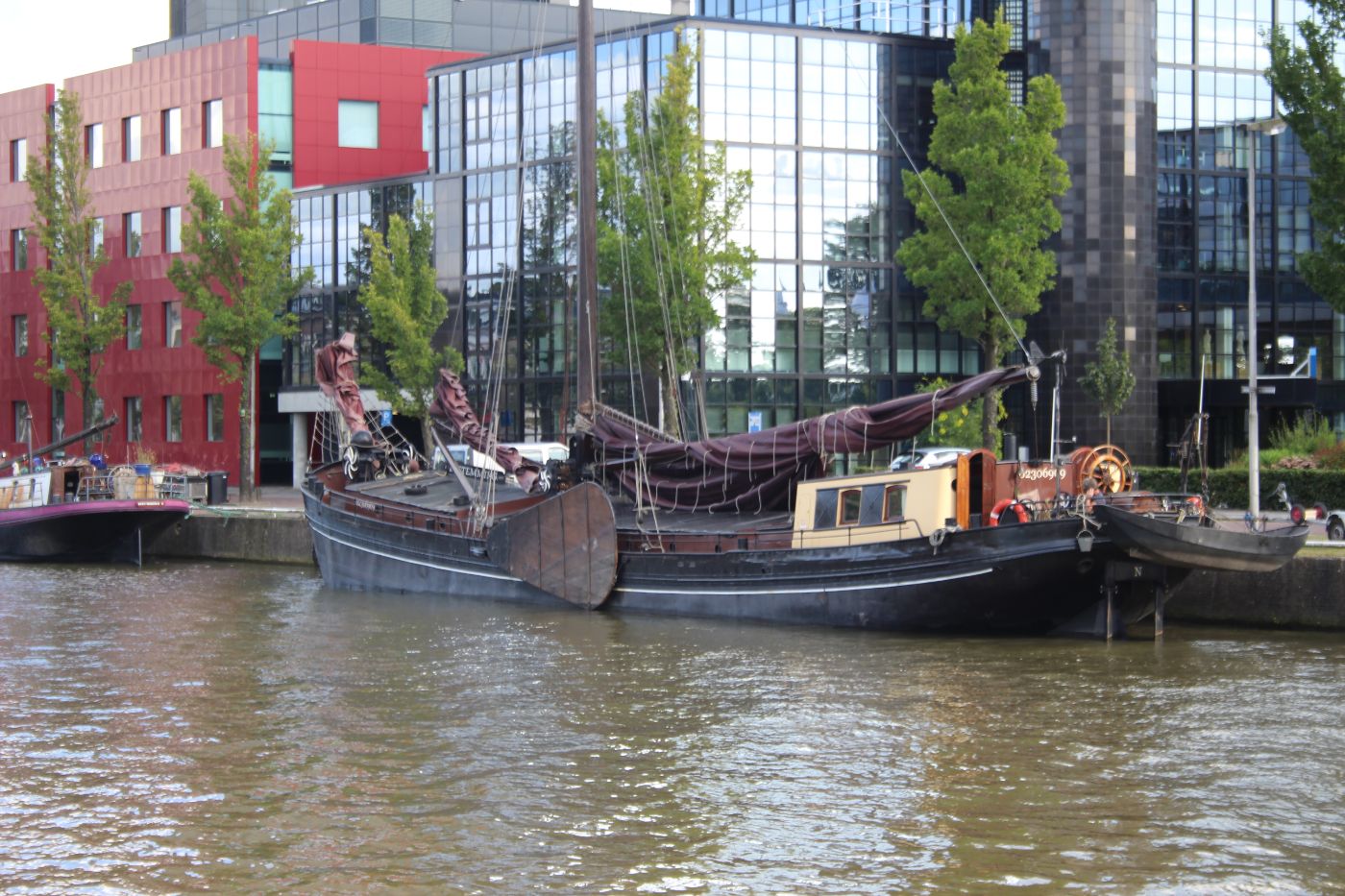
With fin keels, there are different tip designs available. The most common two tip designs are:
These are both variants of the fin keel. Generally, these keel designs are mentioned in one breath with full keels and fin keels, creating confusion on what kind of keel they are. But it's important to understand that they are a sub-category of fin keels.
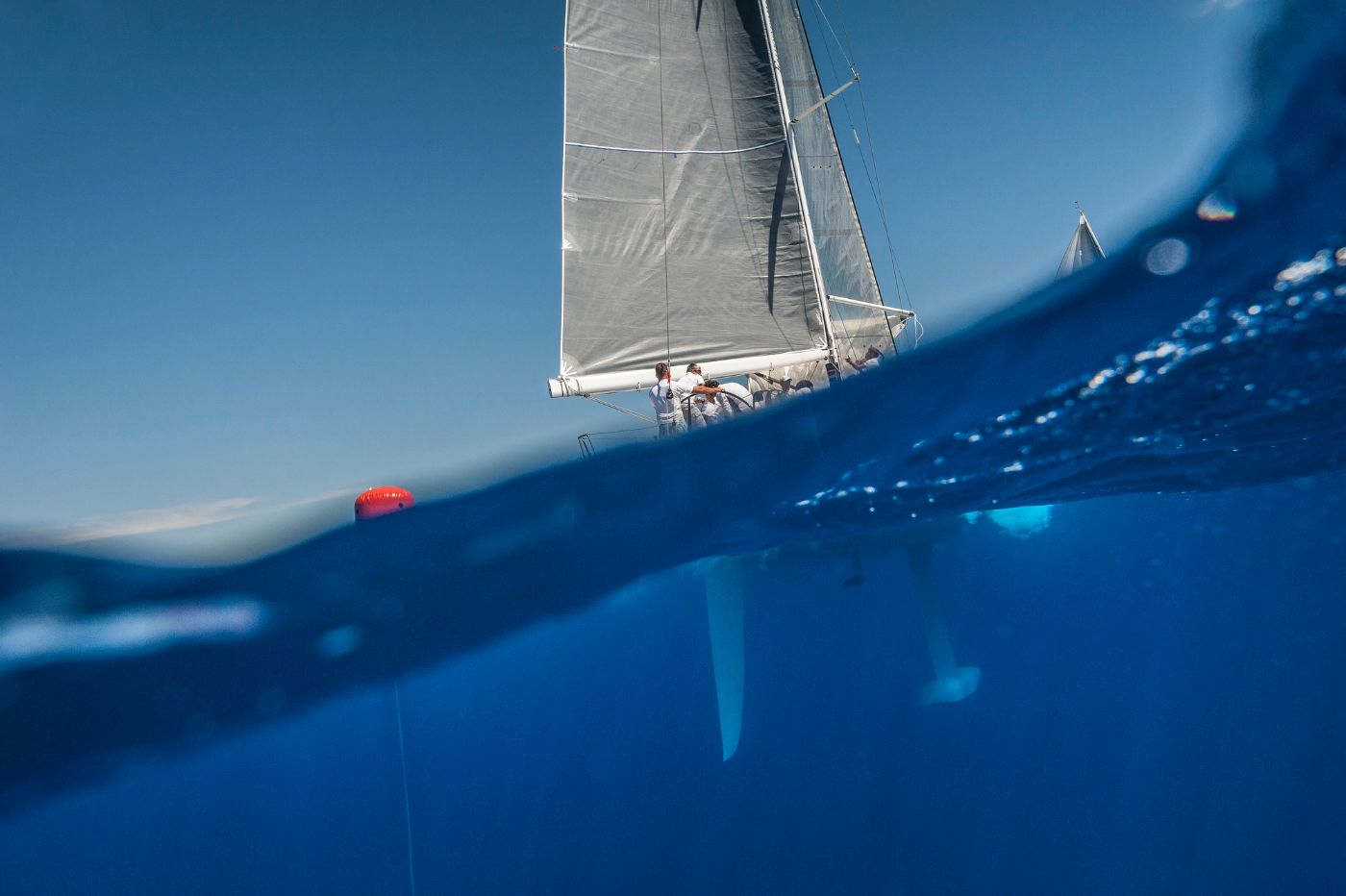
Rudder design
As with the tip of the fin, there are different rudder designs that may apply to both fin and full keels. The two most common rudder designs are:
Skeg rudder
Spade rudder.
A skeg is a structural part of the keel in front of the rudder that protects the rudder. The keel encompasses the rudder, preventing any rogue ropes, weeds, or rocks from damaging the rudder.
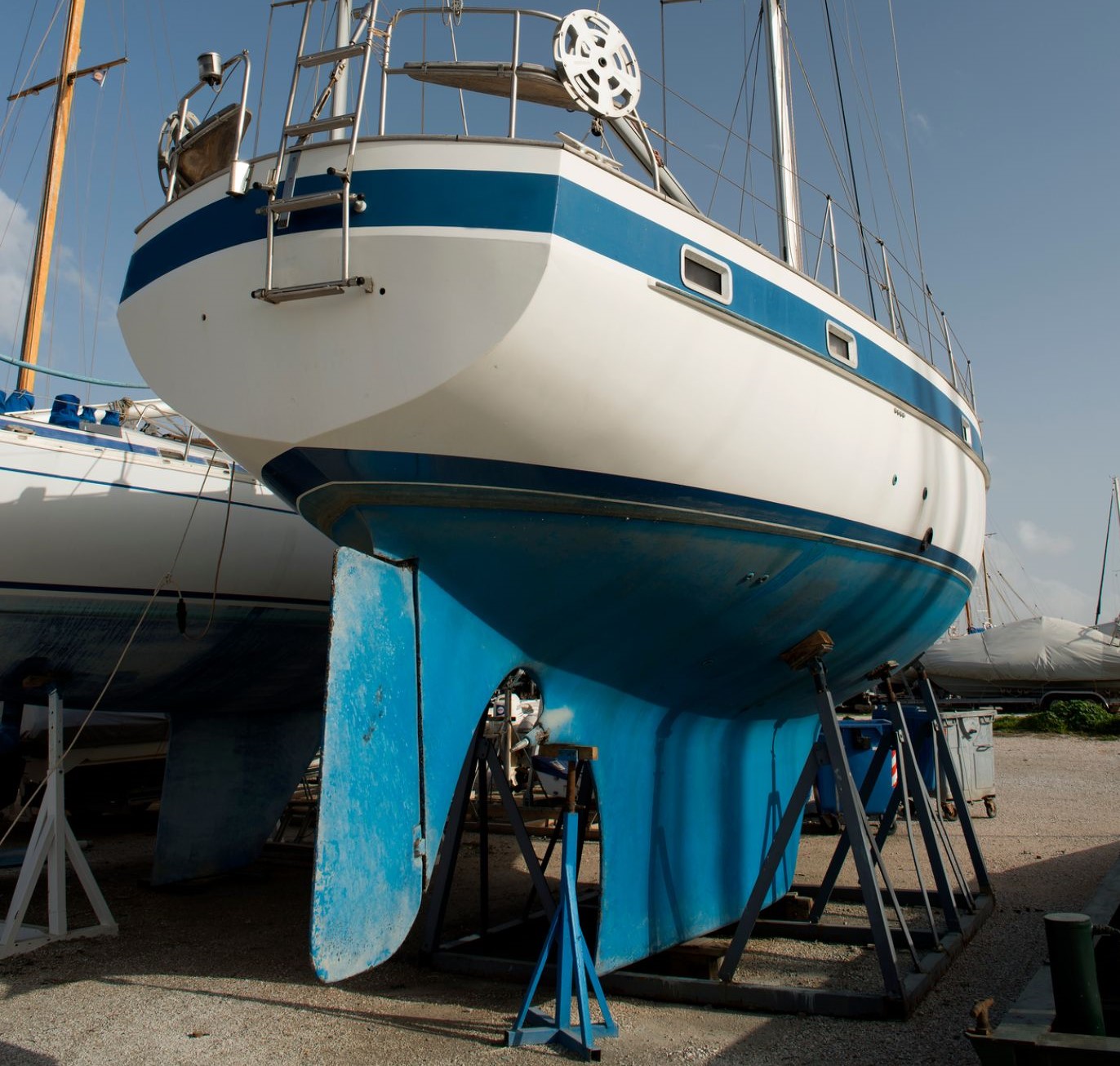
A spade rudder is an unprotected rudder: it doesn't have any structural protection from the keel design. It is simply attached to the hull. This design is very common.
Alright, we understand the big picture. Let's dive into more detail for each keel type and discuss the pros and cons.
Fixed keel Good for cruising and liveaboards Comfortable
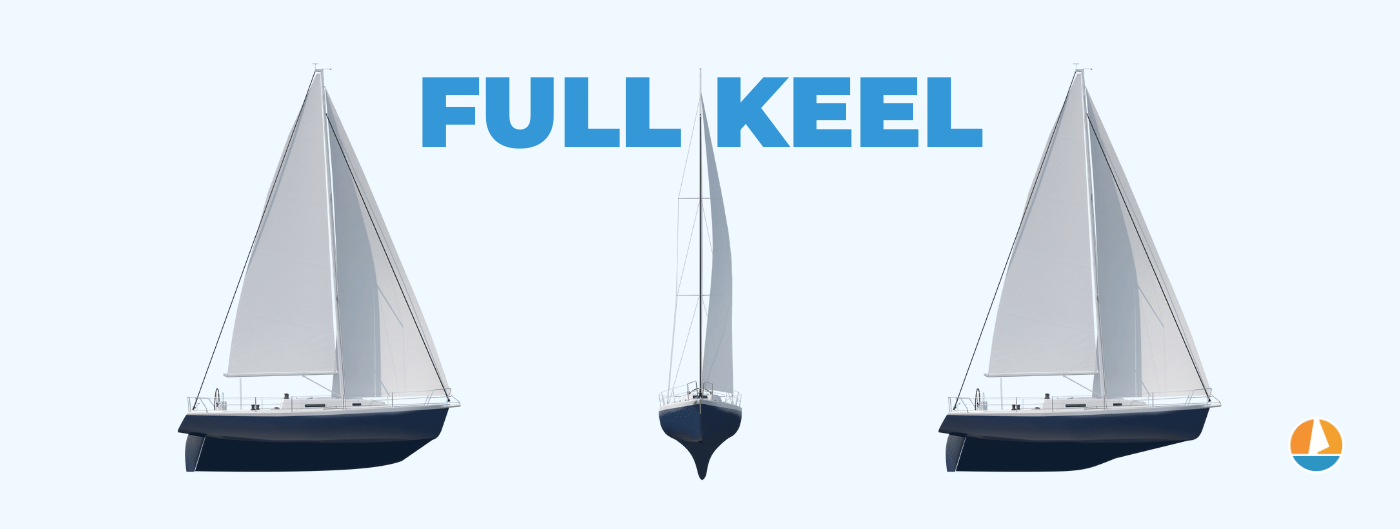
What is a full keel? A full keel runs from front to aft for at least 50% of the hull and is fully integrated into the hull. It has the largest wetted surface of any keel type, and it is also the heaviest. This results in directional stability and reduced heeling, providing the most comfortable ride, but also the slowest.
The wetted surface simply means the amount of water contact area. With such a large wetted surface, it decreases slippage to leeward the most of all keel types, while it counters heeling the most as well.
The full keel is the most comfortable and stable keel type available. However, comfort comes at a price. It delivers the worst performance due to this large wetted area. It is the slowest of the keel types, and it has the worst windward performance.
This makes full keels particularly great for longtime cruisers or liveaboards who prefer comfort over speed, but less ideal for daysailers who need to navigate in and out of slips regularly.
Since it runs for at least 50% of the hull, it doesn't need to run as deep as a fin keel, resulting in a more shoal draft.
Heavier keels result in increased displacement, so a full keel boat will need a larger sail area to compensate for its weight.
For a more detailed discussion on full keel advantages, I recommend reading William's excellent article 5 Surprising Advantages of a Full Keel Sailboat here.
Example sailboats with a full keel:
- Nicholson 22
- Island Packet 380
- Beneteau Oceanis 411 Clipper
- Beneteau First 50
- Jeanneau Sun Shine 38
- Dufour 455 Grand Large
There are a lot of great cruising boats with full keel designs , some of them considered classics.
Full Keel with skeg rudder
Full keels with a skeg rudder design have a protected rudder, thanks to putting a structural part of the keel directly in front of the rudder. This helps with fending off any hazards to the rudder, like floating pieces of rope, rocks, or garbage, and protects it in case of running aground. The skeg design ensures the rudder is nearly impossible to break off.
Fixed keel Good for cruising and liveaboards Faster than a regular full keel

What is a modified full keel? A modified full keel is a full keel with a cutout at the front, reducing the wetted surface slightly, which increases performance without sacrificing too much comfort and stability. After the full keel, it has the best directional stability and the least amount of heel.
The modified full keel is popular among (bluewater) cruisers, thanks to its increased handling and performance. Most modified full keels have a skeg rudder, ensuring it is well-protected.
The slightly reduced weight and wetted surface improve windward performance quite a lot, but it is still one of the most stable keel designs out there.
Example sailboats with a modified full keel:
- Hallberg-Rassy HR 40
- Dufour Arpege 30
- Beneteau Oceanis Clipper 281
- Jeanneau Sun Odyssey 37.2
Fixed keel Good for racing Fast
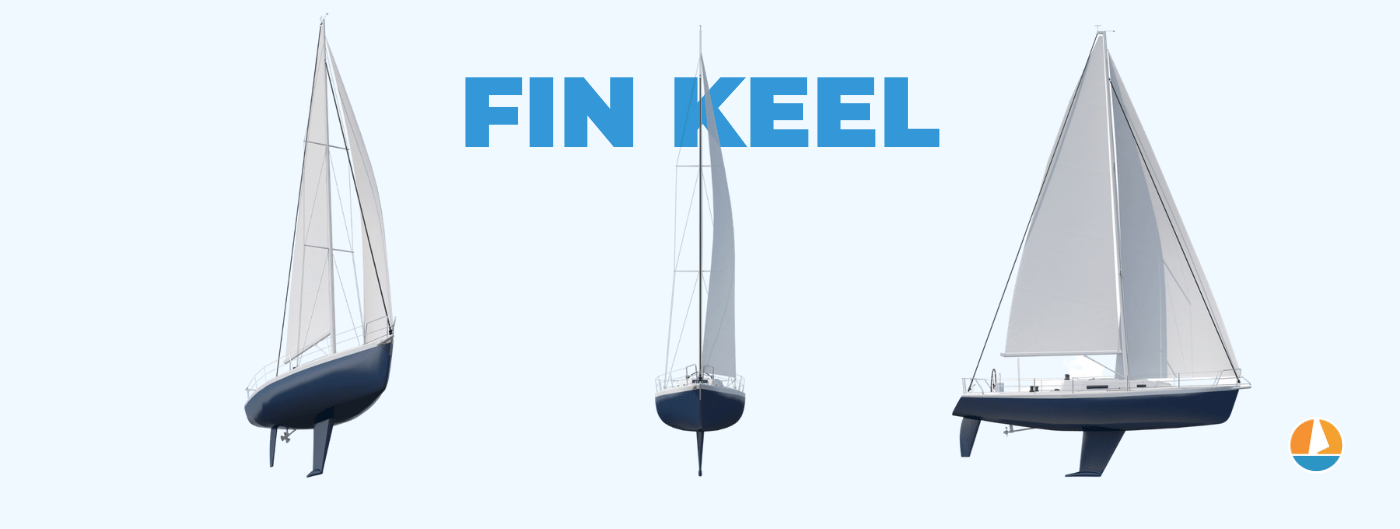
What is a fin keel? A fin keel is a long, weighted blade attached to the bottom of the hull. It is lighter, faster, and more maneuverable than a full keel, but also more vulnerable. The increased distance between ballast and sails provides a lever, reducing the need for a large wetted surface or additional ballast.
Fin keels are generally bolted onto the hull and run deeper and thinner than a full keel. They are also lighter. This helps increasing performance (a lot), making fin keels a lot faster in all situations.
There are some major disadvantages to fin keels, however. Fin keels are a lot less comfortable than full keels and allow for more heel and a less solid track, so less directional stability. Fin keels are also a lot more vulnerable than full keels. They can break off when running aground, or get damaged.
They are very popular among racers and perform better when maneuvering in tight spots, like getting in and out of slips.
Example sailboats with a fin keel:
- Catalina 30
- Jeanneau Sun Odyssey 36.2
Fin keel with skeg rudder
Fin keels with a skeg rudder use a small structural part in front of the rudder to protect it. This design is mostly integrated into the hull, making it less vulnerable, and a great compromise between speed and safety.
Fin keel with spade rudder
Fin keels with a spade rudder have a completely exposed rudder, and typically a fin that is simply bolted on. The keel isn't integrated into the hull, making it more vulnerable and less comfortable.
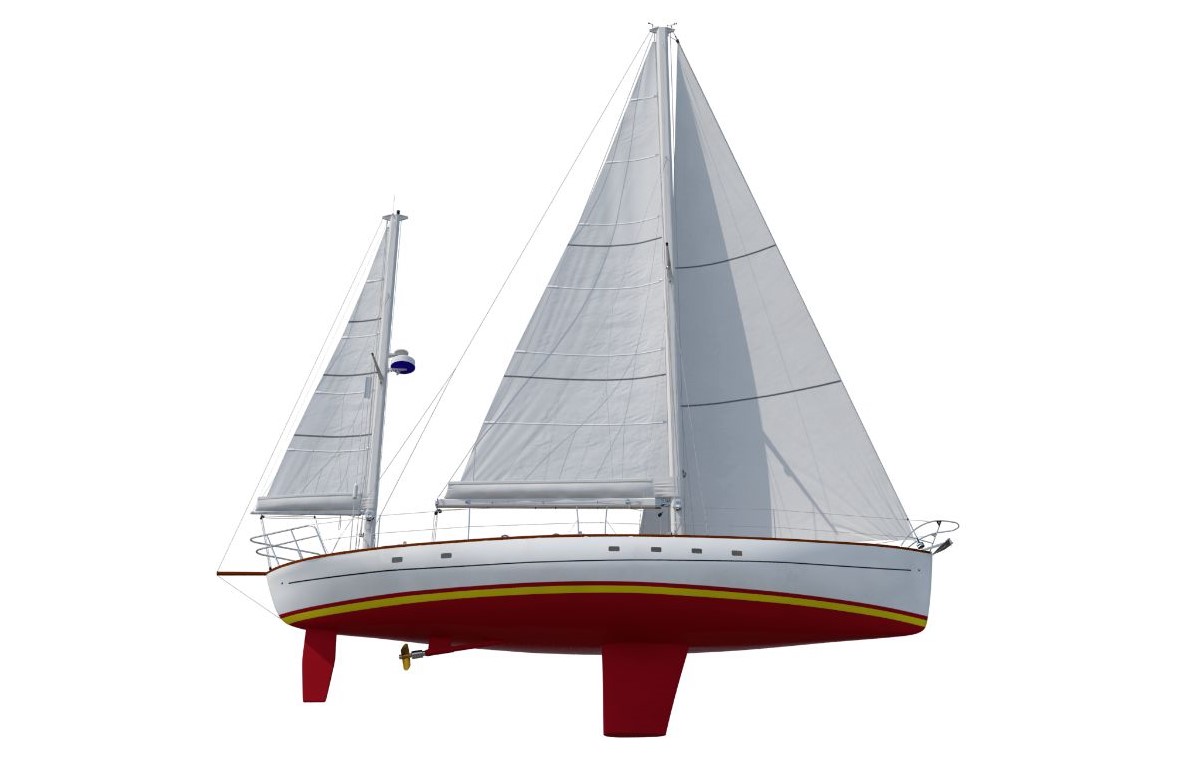
Fin keel variant Good for cruising Less crossflow
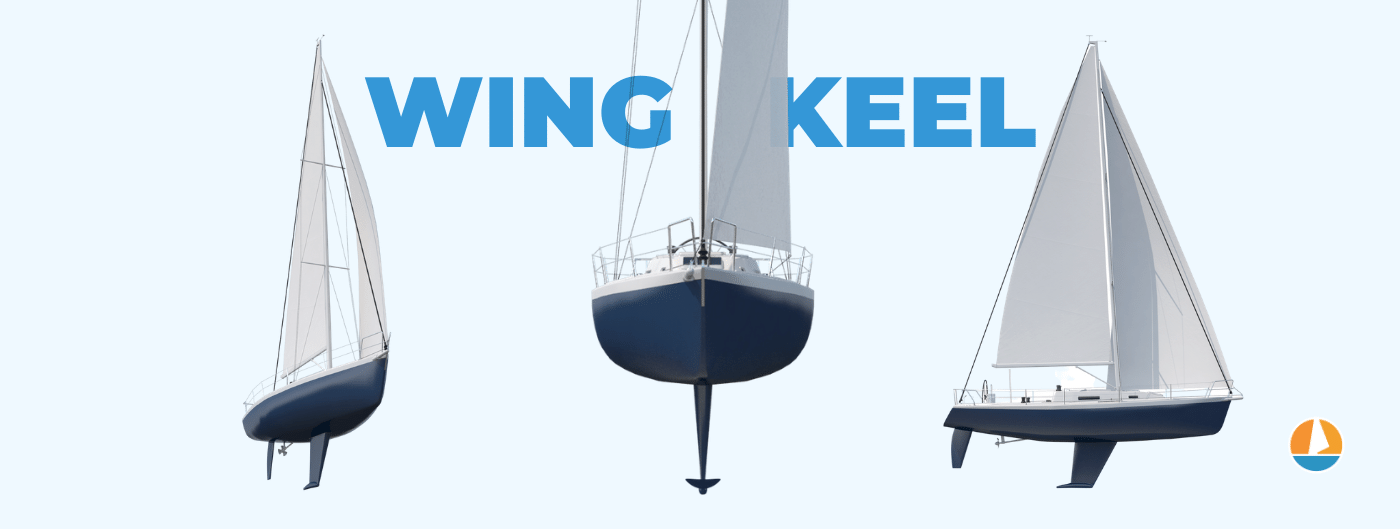
What is a wing keel? A wing keel is a fin keel with a horizontal foil at the tip, which is wing-shaped and generally weighted. Its shape reduces crossflow, improving directional stability, and its ballast decreases heel, resulting in a more comfortable ride. The addition of a wingtip allows for a shorter fin, reducing draft.
Wing keels are good for cruising since this design improves directional stability compared to a regular fin keel or a bulb keel.
We'll discuss the wing keel's advantages and disadvantages in more detail in this article.
Fin keel variant Good for cruising Stability
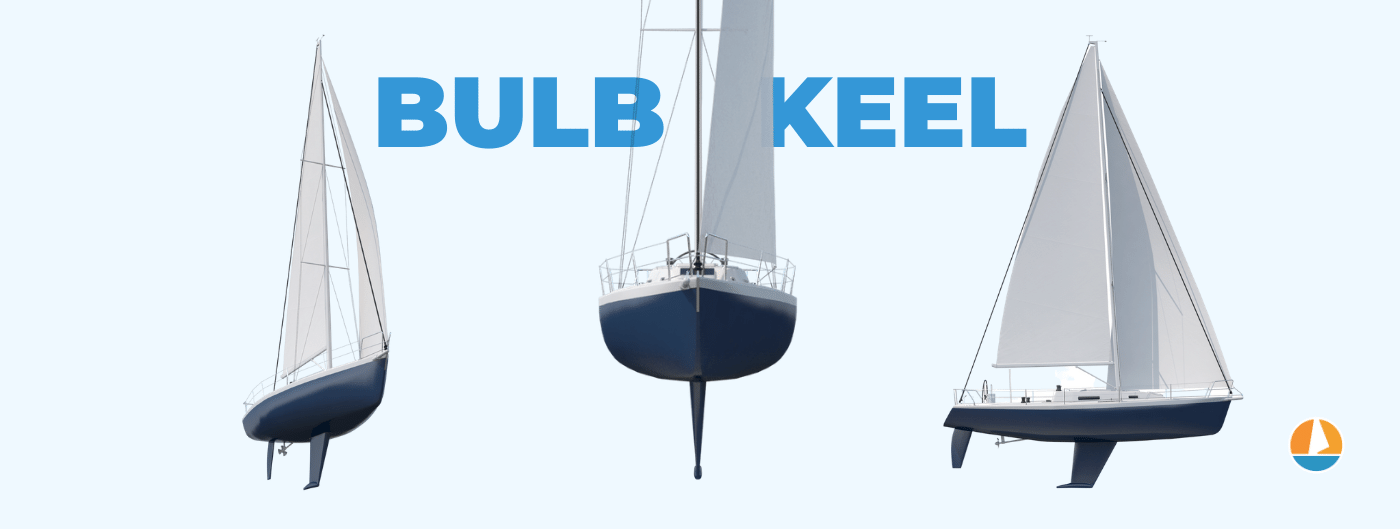
What is a bulb keel? A bulb keel is a high-aspect-ratio fin keel with additional ballast at the end, which generally has a bulb or teardrop shape. This ballast improves stability and utilizes the distance between force and counterforce as a lever. This design reduces the need for a deep fin, resulting in a shoal draft.
By placing the weight at the largest possible distance from the force on the sails, you need relatively little extra weight for the same reduction in heel, making bulb keels very effective for cruising.
This design reduces the wetted area while increasing the weight of the keel just slightly, which increases sailing comfort big time.
Example sailboats with a bulb keel:
- Bavaria B/One
- Beneteau First 24
Fixed keel Good for racing Can be beached

What is a bilge keel? A bilge keel is a twin keel which uses double fins, allowing the boat to be beached and rest on its keel upright. Bilge keels have double the wetted surface, which increases comfort and directional stability while decreasing heel. Modern bilge keels often provide decent windward performance, thanks to better design.
The bilge keel does sacrifice speed compared to the fin keel but doesn't necessarily offer worse performance overall. Older designs performed considerably worse than other keels and were especially slow.
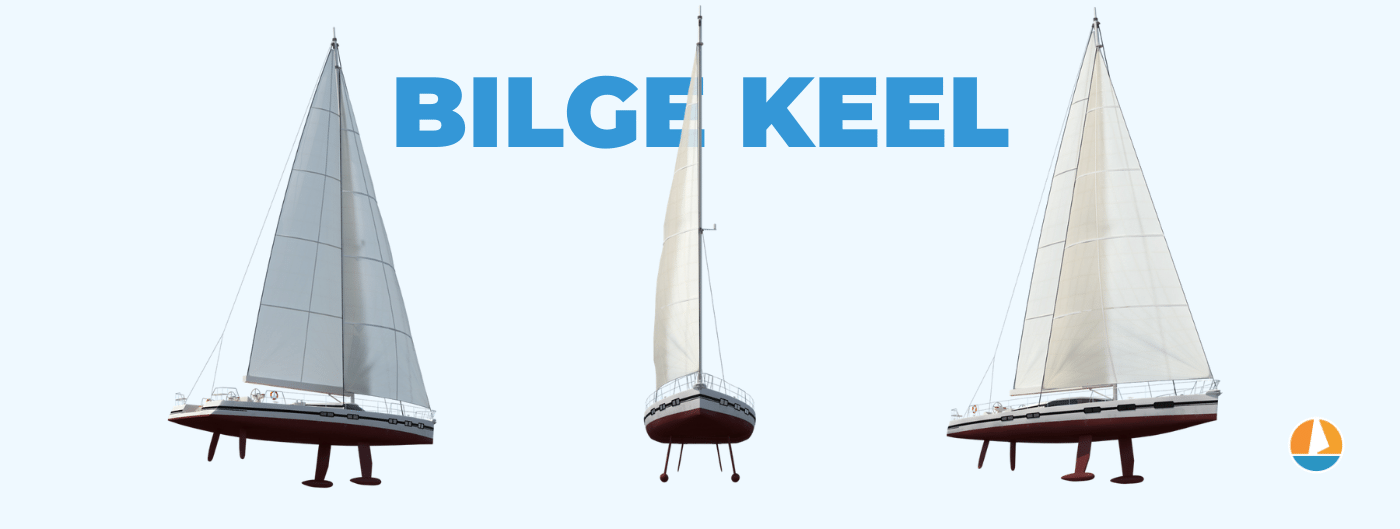
Bilge keels have some major advantages over full keels and fin keels. The most important is that the boat can be beached, making it a popular design in tidal waters. Bilge keels are especially common along the British coastline, where fishermen keep their boats in tidal harbors.
Another major advantage is that the boat can be stored resting on its keels, making dry storage and maintenance a lot easier.
Of course, there are many more pros and cons to the bilge keel , which we go into here.
Example sailboats with a bilge keel:
- Dufour Dynamique 62
- Hunter Duette
- Patagonia Patago 39
- Macwester 27
Lifting keel Good for daysailers Versatile

What is a centerboard? A centerboard is a type of retractable keel that rests on a hinge and can be lowered through a slot in the hull. It folds out like a pocket knife and allows you to increase or reduce the draft of the boat. Centerboards are mostly used on small fishing boats.
The centerboard is a very versatile keel type, allowing you to have both a very shoal draft for inland waters, as well as steadying the boat and reducing heel for larger bodies of water, or even oceans.
I've sailed a Cornish Crabber with a centerboard for a week, and while we stayed inland, having the option to increase the keel depth really came in handy when crossing the IJsselmeer (a former sea in The Netherlands).
There's more to the center
Olaf Roethele
https://www.theyachtmarket.com/en/new-boats/cornish-crabbers/adventure-17/218/
My name is Olaf and I am the owner of a Cornish Crabber 17 Adventure boat.
I would like to ask you if you can imagine to install on this boat a Torqeedo 2.0 Pod motor? Therefore i guess a modification of the keel/skeg is necessary ?!
Best regards from Uruguay,
You completely missed the hybrid planing/water-ballast keel of the Macgregor range
Thanks a lot for this explanation
Roger Bannon
Very well written article which provides an excellent guide for us small wooden boat builders. Thanks.
Leave a comment
Own your first boat within a year on any budget.
A sailboat doesn't have to be expensive if you know what you're doing. If you want to learn how to make your sailing dream reality within a year, leave your email and I'll send you free updates . I don't like spam - I will only send helpful content.
Ready to Own Your First Boat?
Just tell us the best email address to send your tips to:
- 0 No item in your cart
- SUBSCRIPTION
- Classified Ads
- Technical Specifications
- Destinations
- Address book

- All the magazines
Catamaran basics The daggerboards: understanding and adjusting them

Article published on 01/04/2015
By Emmanuel van Deth
published in n°141 may / june
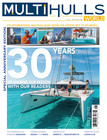
Having a catamaran with daggerboards means enjoying better pointing ability than an equivalent model equipped with fixed stub keels, which are inevitably shorter. It means that you can also optimize drag, speed and even safety. Partially integrated, with foils...an inventory of the daggerboards on our boats and how to use these appendages.
Create a notification for "Technical"
We will keep you posted on new articles on this subject.
1) All the Catanas are equipped with daggerboards. They are very long, and held structurally in their cases by the whole height of the hulls. Simple and strong, but beware of the significant windage in the raised position.
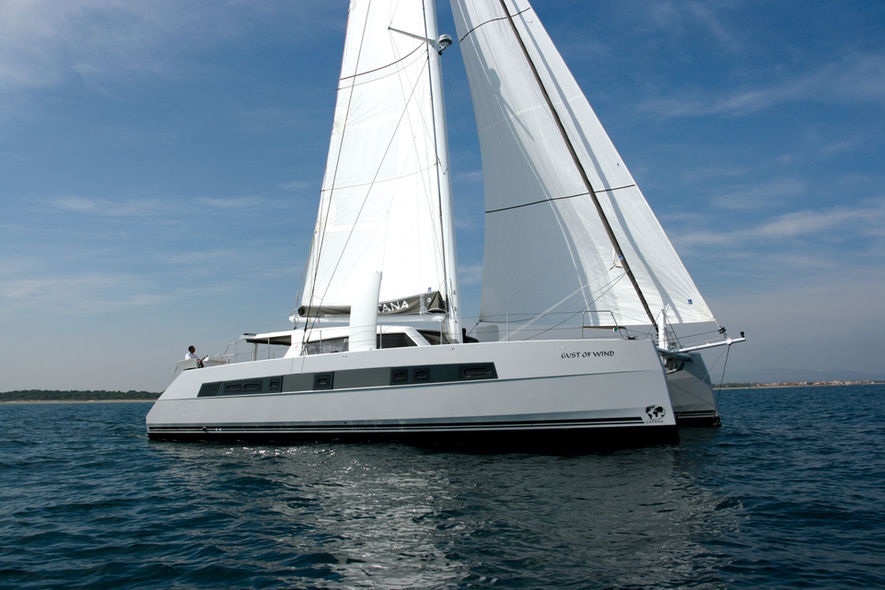
2) The latest Catana models are equipped with curved daggerboards. On the 59, the foil effect is worth 500kg at a speed of 15 knots.
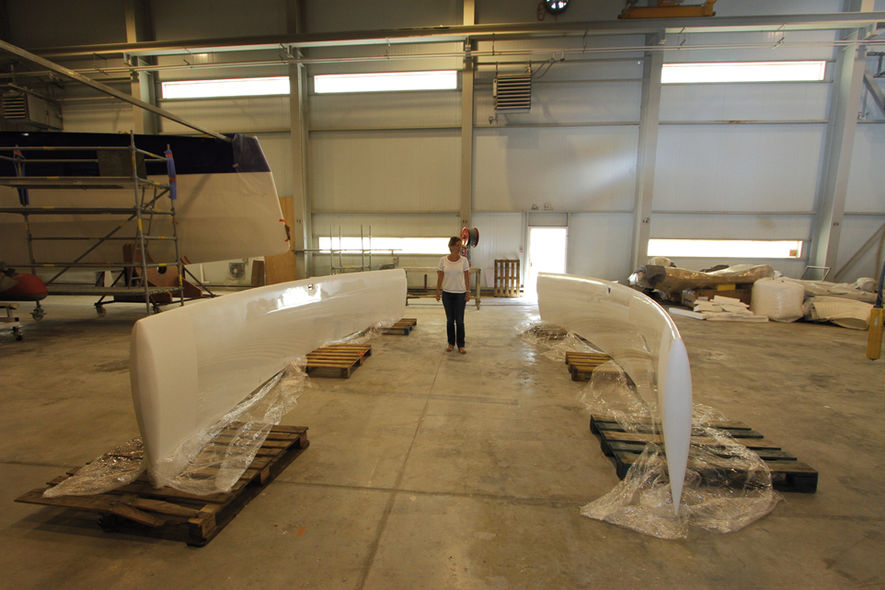
3) The latest Outremers have adopted shorter structural cases, to reduce the size of the daggerboards. Less windage in the raised position and less weight, but the construction is more complex…
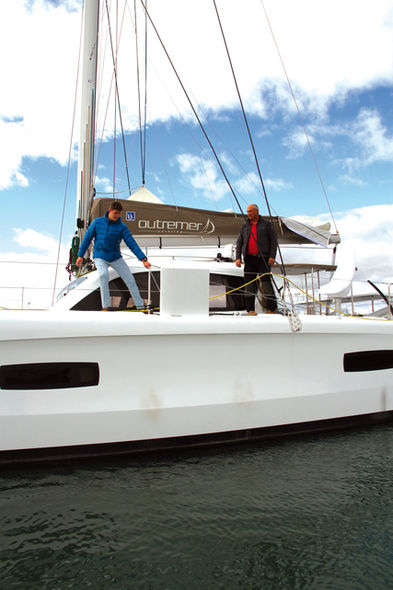
4) Numerous trimarans are also equipped with daggerboards/centerboards. They can be central and integrated into the accommodation, as aboard this Dash 750.
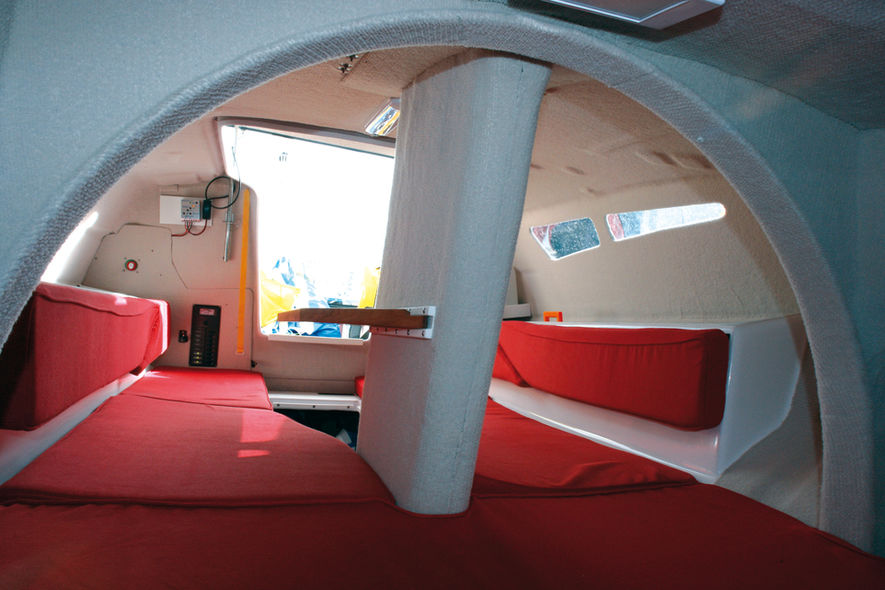
5) Other trimarans, such as the Tricat 25, are equipped with centerboards integrated into the floats.
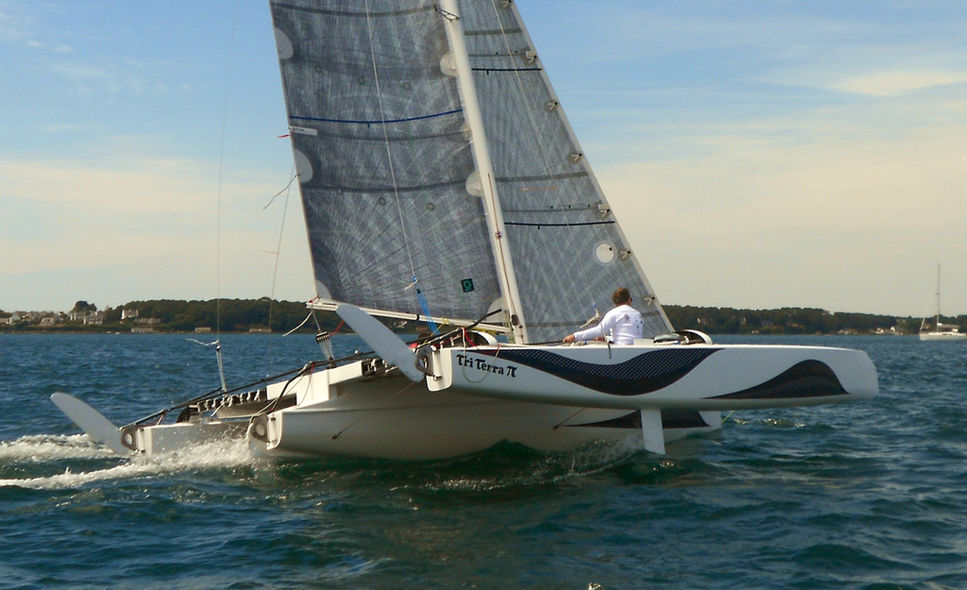
6) Builders such as Outremer provide stopper knots for the daggerboard control lines; a good way to judge the position when the daggerboard is not visible.
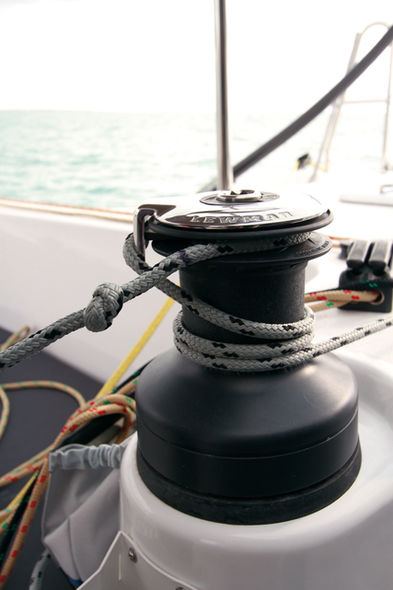
7) Once the daggerboard is out of its case, it is easier to judge: the lifelines are an excellent adjustment indicator!
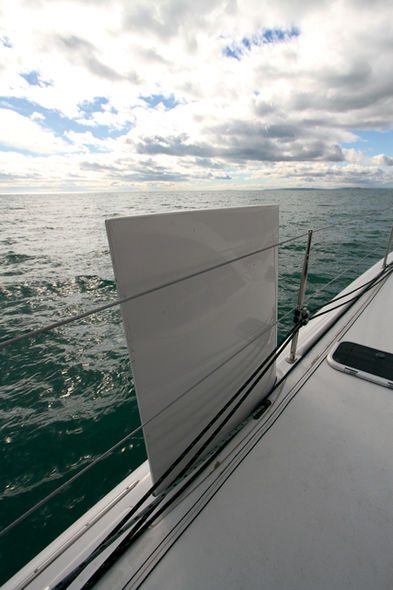
8) To windward in light weather, the daggerboards are fully lowered, to take advantage of maximum 'grip' on the water.
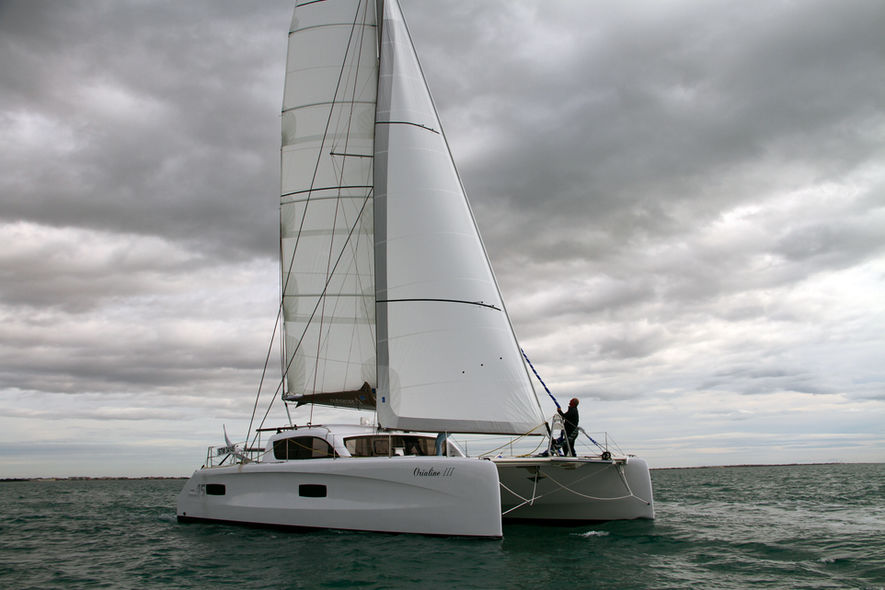
9) When the speed increases, it is worthwhile raising the windward board to optimize drag. Note: a daggerboard which moves is no use. Therefore we raise it!
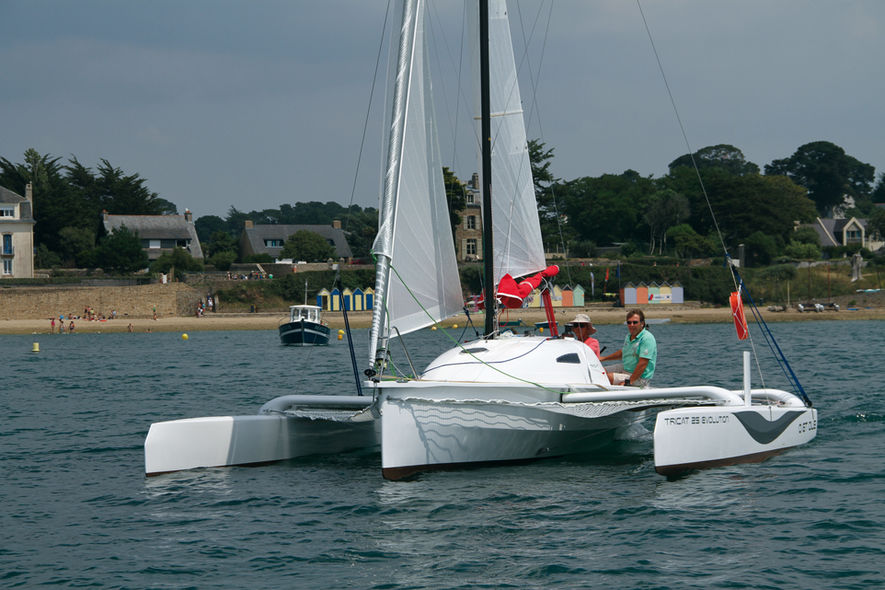
10) But for safety, it is preferable to raise the leeward appendage: in the case of a strong gust, the risk of the boat ‘tripping up’ is thus reduced. The compromise could be to raise both the daggerboards by half... It’s up to you to judge!
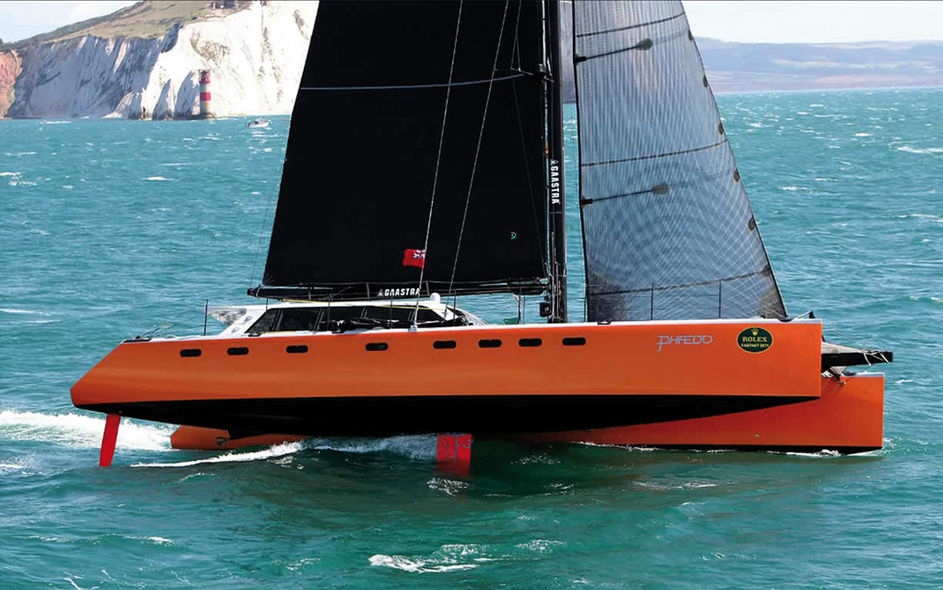
11) Downwind, the daggerboards are no longer useful, especially when the boat exceeds 10 knots... Keeping one third of the surface can however help the helmsman or the autopilot to steer a straighter course.
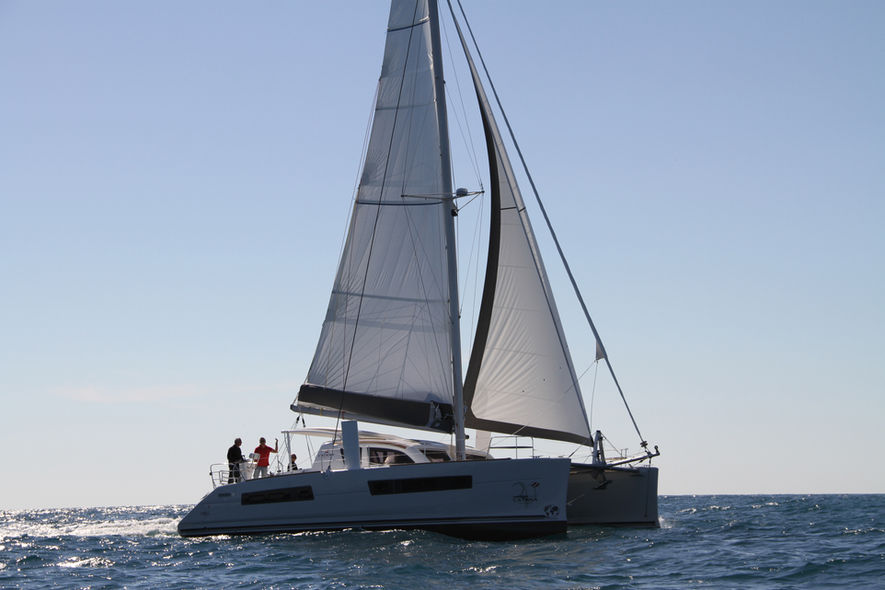
12) Heavy weather? Raise them completely so the hulls slide. On the other hand, with big seas from behind, (just like downwind in more manageable weather) it may be useful to keep a little daggerboard lowered to avoid yawing.
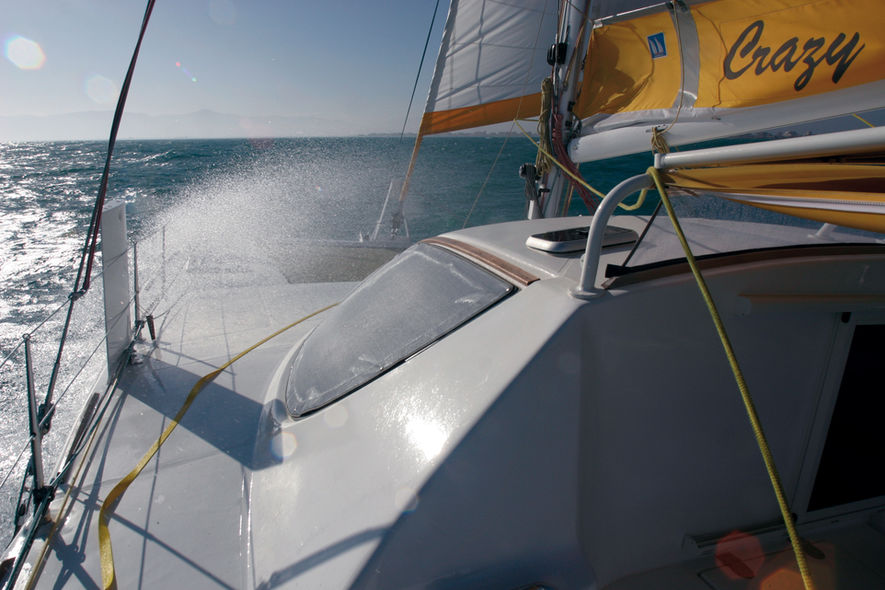
Subscribe to Multihulls World and get exclusive benefits.
Tags :
- préparation ,
- Catamaran basics
Did you like this article ?
Share this article
Most-read articles in the same category.
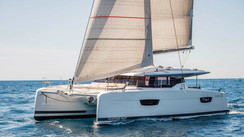
Bending on sails - Everything you need to know for making the most of your multihull
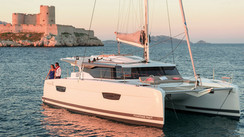
Maintenance - Saildrive legs
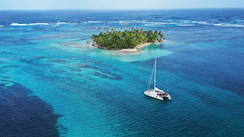
Anchoring - All you need to know about bridles
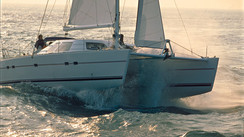
Forepeaks - How do you make the best use of them?
Everything you need to know about trampolines
Davits and arches : Getting your dinghy back aboard your multihull
What readers think.
Post a comment
No comments to show.
Follow us on
Vous avez ajouté " " à vos favoris., vous avez supprimé " " de vos favoris., in order to add this article to your favorites, please sign in..
Catamaran Design Guide
Spectacular sunsets in the Pacific turn the horizon into a brilliant spectrum of gold and orange colors.
Copyright © 2006, 2008 by Gregor Tarjan. Click here for terms of use.
performance, yet desire high daily averages and passage times, which should be as short as possible. When choosing a large multihull, sailors look, above all else, for safety and comfort, long before the consideration for flat-out speed comes into the discussion. Nevertheless, performance is a highly important design consideration. No catamaran sailor wants to sail slower than a same length ballasted keelboat. Below are some EVALUATION & COEFFICIENTS useful coefficients, which will help compare monohulls and multihulls objectively.
Bruce Number (BN)
below "Indigo," a magnificent Wormwood 70, sailing in sparkling Caribbean waters.

Various multihull characteristics and design features can be expressed in mathematical formulas. Their results are crucial and will give prospective owners a basis of comparison between different types of catamarans. These numbers are important, as they eliminate ambiguity and clearly display various advantages or concessions of a design, which would be hard to quantify any other way. Mathematical coefficients not only will provide insight into a boat's performance in varying conditions, they also reflect concerns about loads to be carried safely, speed and stability.
We have already mentioned the Displacement/Length and Sail Area/ Displacement ratio in our chapter on Multihull Advantages, illustrating the point of a multihull's efficiency. Let's look at some other coefficients that give us an indication of a boat's performance.
What is performance and how do we really measure it? Most people who buy a cruising catamaran are not really interested in racing
The Bruce Number is very similar to the Sail Area to Displacement ratio although the formula is slightly different. It is the square root of the sail area in feet, divided by the cube root of the boat's displacement in pounds:
SA = upwind sail area (mainsail and 100% jib)
Displ = weight of the boat in pounds
Similar to the Sail Area to Displacement ratio, the higher the coefficient the faster the boat and better is its performance in light air. Typically a BN of 1.1 will be the threshold between fast and more sluggish multihulls. A heavy displacement monohull might have a BN of .7, whereas a modern cruising catamaran shows a BN of 1.3. Offshore multihull racers can have BNs of 2.0 and higher. The BN will also tell us about a catamaran's ability to withstand stronger winds before reefing. A boat with a higher BN is usually overcanvassed in strong conditions and will have to be reefed earlier than one with a lower coefficient.
On the other hand, they will be able to produce more "power" than their counterparts in lighter winds and perform better.
Sail Area to Wetted Surface (SAWS)
SA/WS = Sail Area Wetted Surface Coefficient
SA = upwind sail area
WS = total underwater surface area (hull and appendages)
This formula simply divides the upwind sail area of the boat (mainsail and 100% jib) by the wetted surface. This coefficient will give us a statistical indication of the multihull's lightair performance since in low wind conditions skin friction becomes an important factor. Monohulls can have coefficients of at least 7% more than multihulls.
Hull Fineness Ratio (HFR)
The Hull Fineness Ratio, known as the hull's beam-to-length ratio, is an interesting number. It is derived by simply dividing the waterline length of the hull by the waterline beam of the hull.
Max. WL/Max. Beam WL = Hull Fineness Ratio Max. WL = length of the hull at waterline in ft. Max. Beam WL = beam of the hull at the waterline in feet.
Monohulls, when compared to multihulls, have low hull/fineness ratios. In Part 1 of this

book, discussing "Efficiency," we saw that ballasted keelboats are limited to Archimedes' principle of hull speed (1.34 x VWL). Multihulls do not have these theoretical barriers, because their hulls are narrower.
The thinner the hull the faster it will be able to travel through the water. But, attention! It will also carry less unless you are on a mega cat. Typically, a 40' cruising catamaran's HFR will range from 8:1 to 10:1. Dennis Conner's above While sailing under spinnaker and experiencing virtually no roll at all, guests will always find a comfortable spot to relax on the foredeck, an impossibility on a monohull.
There are various methods of calculating the transverse stability of a catamaran. One of the simplest and most utilized techniques is establishing a relationship between the height of the Center of Effort (CE), displacement, beam and sail area. Multihull designer, James Wharram added safety factors of 20% to compensate for gusts and the dynamic environment of the ocean. Another method is described in the text below.
Multihull Stability & Capsizing Moment d - Displacement (kg) x half beam (m) max ~ Sail Area (sq m) x Height of Center of Effort (m)
P max = maximum pressure exerted onto sails
Multihull Stability & Capsizing Moment

height of sailplan CE
half overall beam (half hull beam)
racing cat "Stars and Stripes" had a 16:1 HFR. Of course, the larger the boat, the narrower the hulls will become in comparison to its length. For example, the HFR of a 100' luxury catamaran may be 12:1, providing it with a high speed potential. However, monohulls can show HFRs of 3:1, though the comparison is complicated as their angle of heel affects the measurement.
One has to be very careful when analyzing the Hull Fineness Ratio of a cruising catamaran, because other factors such as the actual shape of the hull cross sections (Prismatic Coefficient, PC) can throw the analysis off balance. Go-fast sailors like to think that fine hulls are always fast. That is not necessarily true because a slim hull could have a large underwater volume, thus slowing it down. Consequently, a wide waterline-beam hull could have less drag than a narrower one. It could have a shallow underbody (low PC), which would be beneficial to load carrying (Pounds Per Inch Immersion Number, PPI) and early surfing characteristics at speed.
Stability Coefficient (SC)
This mathematical formula has been devised by the distinguished catamaran designer and sailor James Wharram and his team. This coefficient analyzes a multihull's ability (in a static environment) to resist capsizing due to wind.
( 0.682 VW x (.5 Boa) ) x .555 = CW .00178 x SA x h
W = Wind speed, apparent, in mph CW = Critical Wind Speed to capsize in mph SA = upwind sail area in sq ft. h = height of Center of Effort (CE) of total sail area
Boa = Beam overall
This formula will tell us how much wind it will take to overturn our multihull. By instinct we will know that a catamaran with a wide stance and a conservative sail plan will be very stable offshore. The SC formula will inevitably illustrate that a wider beamed catamaran with a tall sail plan will be as resistant to wind induced capsize as a short-rigged, narrower boat. This is not so if one considers the chaotic environment of waves and the real world of heavy weather sailing. It is interesting to note that a wide beamed boat (regardless of the SC) is more resistant to capsize in seas due to the effects of a higher moment of inertia. In an open-ocean environment, which is everything but static, the SC formula has little meaning. Nevertheless, it serves as a good basis to evaluate stability as a factor of wind force.
below When the wind suddenly comes up, all that is needed is a couple of turns on the jib furler to quickly reduce the headsail size. The catamaran will hardly sail any slower, but feel more comfortable.

Wide hulls and a large overall beam will increase the overall righting moment of a catamaran. A word of caution: Excessive beam will reduce the fore and aft stability. Designers strive to compromise hull fineness ratios, place heavy weights towards the CG (Center of Gravity), and engineer hull and overall beam to achieve a seaworthy balance, which is safe, yet provides ample liveaboard accommodations.
Catamaran Stability Considerations

Diagonal Stability & Beam-to-Length Ratio (BLR)
Stability of a multihull, or the resistance to capsize, should be seen as three components. Athwartship Stability is one well-publicized type and the one often talked about. The other much more important types are Fore and Aft and Diagonal Stability. Fore and aft stability is established by the relationship between the boat's waterline length and the distance between the hull centerlines. It will reflect the catamaran's resistance to tripping. This relationship should be in the vicinity of 39% to 42%. For a seaworthy cruising multihull it is important maintain the proper ratio between length and beam, which, in turn, balances equal amounts of athwartship with diagonal stability. The goal should be to prevent the possibility of a sudden discrepancy of powers between fore and aft and sideways resistance. Most of today's multihulls keep these two component forces in equilibrium, making them extremely seakindly and safe.
Some early design multihulls were very narrow, partly due to the material limitations of that time. But things have changed. Contemporary composite construction allows designers to build wider boats without compromising stiffness. Production catamarans of today have a wide stance and have the benefit of greater safety margins in gusty wind conditions than their older cousins. Multihulls are sophisticated structures and true modern miracles. They provide a more comfortable ride and more interior room. Thanks to modern materials they weigh less and perform better than catamarans built only 10 years ago.
Some catamarans, especially production boats, which are very popular in the charter fleets, are growing wider by the year. The businesses who rent these beamy monsters adore them. Lots of room plus open decks are ideal for clients and the bigger (wider) the boat, the more paying guests can share the fees. But there certainly is a limit as to how wide is too wide. Extreme beam can be dangerous. It can lead to instability fore and aft and to excessive bridgedeck slamming, as the relative distance from the bridge deck to the water will decrease with an increase in width. A vessel with excessive beam might seem stable athwartships, but it will compromise overall stability.
We know that multihulls can, in extreme cases of seamanship error in wild storms, be thrown over from any side - front, back and beam-on. The best examples of this phenomenon are racing multihulls, especially Formula 1 trimarans, which have fine hulls for speed and huge sailplans to provide driving power. They are initially extremely stable athwartships (High Beam-to-Length Ratio), but have a tendency to become unstable fore and aft. They will surf down waves and reach a point where the power of the sails, and speed, will exceed the ability to keep the bows out of the water and the boat will pitchpole. This is the reason why catamaran designers usually draw their multihulls with a Beam-to-Length relationship of between 50% and 55%. The longer the vessel the lower that percentage becomes.
I am currently involved in the "Gemini" project, which presents an example. It very well might become the world's largest sailing catamaran. She will have an overall length of 145 feet, yet her beam will "only" be 54.4'.

Please, don't worry. "Gemini" will not be tender and tip over in the slightest breeze. On the contrary, this monster will be one of the most stable craft afloat, although the beam-to-length relationship is only 37%. The relatively low beam-to-length ratio also involves the fact that the boat would be too heavy and building costs would be prohibitive if she were to have a standard 52% BL relationship. Most importantly, could you imagine turning a 75-foot-wide boat?
above Asymmetric spinnakers on furlers are great inventions. They add instant sail area, yet can be doused in a matter of seconds when the wind picks up strength.

above Although this Edel 35 was a good-looking and popular catamaran, it suffered from excessive bridgedeck pounding, which was caused by only several inches of clearance between the saloon's underwing and the sea.
Obviously there is a sweet spot in the beam vs. stability question. Designing too beamy a boat will also necessitate more freeboard to preserve bridgedeck clearance which, in turn, will increase windage and complicate maneuvering. Unless sophisticated aramid construction methods are utilized, more beam will also add more weight and stress to the structure. Adding more mass will, to a certain point, help make the boat more stable, but where do we stop? Is it better to add weight or width to make a boat stiffer? Of course, both characteristics are interrelated as a beamier boat normally is also heavier. Just adding weight to a catamaran simply to make her more stable will not pay off. Consequently, making a boat too wide might increase living space yet it will also burden the structure, require a beefier manufacture, and yield an even heavier boat. Needless to say, a boat which is too wide will also create practical restrictions such as maneuvering, the ability to haul the vessel and much higher building costs.
Beam has a great effect on bridgedeck clearance, which is one of the most vital characteristics of a good cruising catamaran. As standard practice, the well-known rule of 1" of bridgedeck clearance for each foot of beam was a safe way to prevent excessive wave slap. The wider the beam the more the relationship changes and the necessary height of 1" per foot of beam needs to be increased to 1.3" or more. In the extreme case of overly square boats, that number will have to be closer to 1.8" per foot of beam. This will have a negative effect on any seaworthy multihull that has a bridgedeck saloon. The wide beam will necessitate a high cabin sole to remain a safe distance from the waterline. In order to provide standing headroom, the coachroof might be higher than practical, which could result in a boxy, high-windage multihull. Not only will this be unattractive, but also raise the Center of Gravity (CG) which really should be kept as low as possible.
More overall beam on the other hand (given that there is still sufficient bridgedeck height) has a less known benefit, as it reduces the possibility of hull-wave interference, which is particularly important for fast designs. The wave interaction between the hulls can lead to additional resistance, and especially in an agitated sea state, the formation of wave crests can pound the bridge deck. Most early narrow-beamed catamarans suffered from this phenomenon,
Ultimately, a boat's design has a major influence on its ability to stand against the forces of nature, and to keep occupants safe. Manufacturing excessively wide catamarans is like trying to market monohulls with super deep-draft keels. Both are totally impractical. We designers have to make sensible compromises and learn from past experiences of what has worked at sea by balancing the benefits of a wide boat with its disadvantages.
below This narrow-hulled Outremer 64 Light has completed her third circumnavigation with the same owners. Note the smooth underwing clearance, lacking any protrusions or steps.

"A great cape, for us, can't be expressed in latitude and longitude alone. A great cape has a soul, with very soft, very violent shadows and colors. A soul as smooth as a child's, and as hard as a criminal's. And that is why we go!"
~ Bernard Moitessier

Dinghies, windsurfers and every imaginable type of water toy can be stored conveniently on large catamarans and easily launched from the wide transom steps for shore-side pleasures. Note the twin life rafts located in special compartments on the massive aft crossbeam.
Continue reading here: Hull
Was this article helpful?
Related Posts
- Design Dynamics - Catamarans Guide
- Hull Construction - Ship Design
- Geometry - Ship Design
- Principles of Yacht Design Ena
- Heavy Weather Tactics - Catamarans Guide
Readers' Questions
What length should a stub keel be to waterline length on a catamaran?
There is no set rule for the length of a stub keel on a catamaran in relation to its waterline length. The length of the stub keel will depend on various factors, such as the size and design of the catamaran, intended use, and specific requirements of the boat builder. Generally, the stub keel on a catamaran is designed to provide stability and improve sailing performance, so it is important to consult with a naval architect or boat designer to determine the appropriate length for a specific catamaran.
What is a 16 passenger catarmarn like?
A 16-passenger catamaran is a type of boat or vessel specifically designed to carry 16 people comfortably. Catamarans are multihull boats with two parallel hulls, which are connected by a deck or a structure. They offer stability, speed, and efficiency in the water. A 16-passenger catamaran can vary in size and design, but generally, it will have enough seating or lounge areas for all passengers. It may have indoor cabins with beds or seating areas, as well as outdoor spaces for relaxation or socializing. These boats often come equipped with amenities such as bathrooms, kitchens or galleys for meals, and sometimes even entertainment systems. The catamaran's size can influence its specific features. Some catamarans are designed for day trips or shorter excursions, while others are built for longer journeys or overnight accommodations. Additionally, they can be used for various purposes, such as whale watching, diving trips, ferry services, or private charters. Overall, a 16-passenger catamaran provides a comfortable and stable platform for small groups or gatherings, allowing passengers to enjoy the beauty of the water while ensuring safety and comfort.
Is the catamaran hull floor always on the waterline?
No, the hull floor of a catamaran is not always on the waterline. The design of a catamaran allows for the hulls to be elevated above the waterline, reducing drag and increasing speed. The position of the hulls in relation to the waterline can vary depending on factors such as the weight distribution, load, and sailing conditions.
How close to a catamarans design reefing points should you go?
You should always be careful when approaching reefing points on a catamaran and stay as far away as possible. Generally, you should aim to stay at least 10 meters away.
What keel to length ratio for catamarans?
The keel-to-length ratio for catamarans typically ranges from 0.1 to 0.25.
Is 70% length to beam ok for a catAMARAN?
Yes, it is generally accepted that a catamaran should have a length to beam ratio of between approximately 6:1 and 8:1. Therefore, a 70% length to beam ratio would be within an acceptable range.
What is the waterline length to baem ratio of a typical cruising catamarans?
This ratio will vary depending on the type and size of the catamaran. Generally, the ratio should be between 1:1.5 and 1:2.5, with 1:2 being the most common.

Top 6 Characteristics of a Good Catamaran
What Makes a Good Catamaran?
As we (Stephen and Estelle) self-isolate during this pandemic aboard Zuri, our Bali 5.4, we thought we would share some insights about important features you should think about when buying a catamaran. We started out with 5 then at the end, Stephen threw in another 3. What are your thoughts? What are important features on a catamaran. Let us know below in the comment section.
Like all marine vessels, certain characteristics make some catamarans better than others. You will not find a perfect catamaran because no boat is perfect. Compromise is always required. But with forethought about how you will utilize your multihull, and matching your requirements to high quality design, you can get pretty close to your “dream” catamaran.
Crucial attributes to consider for a cruising catamaran are:
- Weight-carrying ability
- Bridge deck clearance
- Structural integrity and seaworthiness
- Windward ability
- Deck surface design
- Ease of handling
We will explore each of these catamaran characteristics, and how they affect performance, comfort, and, ultimately, safety.
Early catamaran designs were heavy by today’s standards. The multihulls were designed with a narrow beam, high freeboard, and inefficient underwater design. They were prone to hobby horsing and pitching. Today, with the technological advancements of lighter, stronger composite materials, catamarans performance has greatly improved.
In the last 20 years or so, boat builders have painstakingly studied and resolved the issues affecting catamarans, effectively increasing their seaworthiness by leaps and bounds. Constant reform and transformation of even the basic tenets of catamaran design continue today as is evident in the radical catamaran designs in the 2013 America’s Cup Challenge. (The foiling Gunboat G4 designs spring to mind). In fact, many of the problems of the older multihull designs have been eliminated altogether.
The new generation of cruising catamarans offers exciting, fun sailing vessels with great livability, space, comfort, and safety. This was made possible, in no small part, by the early multihull pioneers.
Catamaran Stability & Weight-Carrying Ability

WEIGHT: Unlike the monohull design that can carry weight without much loss of performance, an overloaded catamaran rapidly loses performance and, eventually, safety. In order to counter this, multihull manufacturers are continually looking for ways to reduce construction weight to increase the potential payload capacity while retaining optimal performance.To select a light catamaran, look for hulls with cored construction and interiors built with lightweight materials. Lighter construction enables catamarans to carry more weight and perform faster, so this characteristic is very important when selecting a cruising catamaran.
Monohulls can heel and spill wind when the sails are overpowered. But a catamaran’s only available response to pressure of a wind gust is to accelerate. So the boat has to be very strong to hold together. Cored construction makes the catamaran strong and very stiff. Stiffness gives a catamaran good performance.
Consider that the catamaran’s hulls are actually two boats joined together by a bridge deck. These “boats” are constantly fighting each other and trying to go in their own direction. The boat structure must be strong enough to counter this and, at the same time, deal with the downforce of the mast in the center of the bridge deck. The catamaran performs an amazing feat contending with all the opposing forces inherent in the multihull design. For that reason, it is critical to ensure the design and manufacturer are reputable with a track record to demonstrate structural integrity.
STABILITY: Unlike monohulls that rely on a heavy lead keel to keep it upright, a catamaran relies on the beam of the boat and the buoyancy of the hulls for stability. Typically cruising catamarans will have a beam to length ratio of roughly 50%. So a 45-ft long catamaran will be about 22-ft wide, providing a very stable platform. Good stability in a catamaran is when the righting forces and healing forces are in balance. So if the righting moment is greater than the capsizing moment, the boat stays upright. When the capsizing moment becomes bigger than the righting moment due to an increase in wind, the boat starts to capsize. <
This diagram and article by James Wharram , king of “self-build” catamarans, offer valuable insight into catamaran stability. Also, read this article by Shuttleworth “ Design Considerations for Seaworthiness “.
Catamaran Bridge Deck Clearance
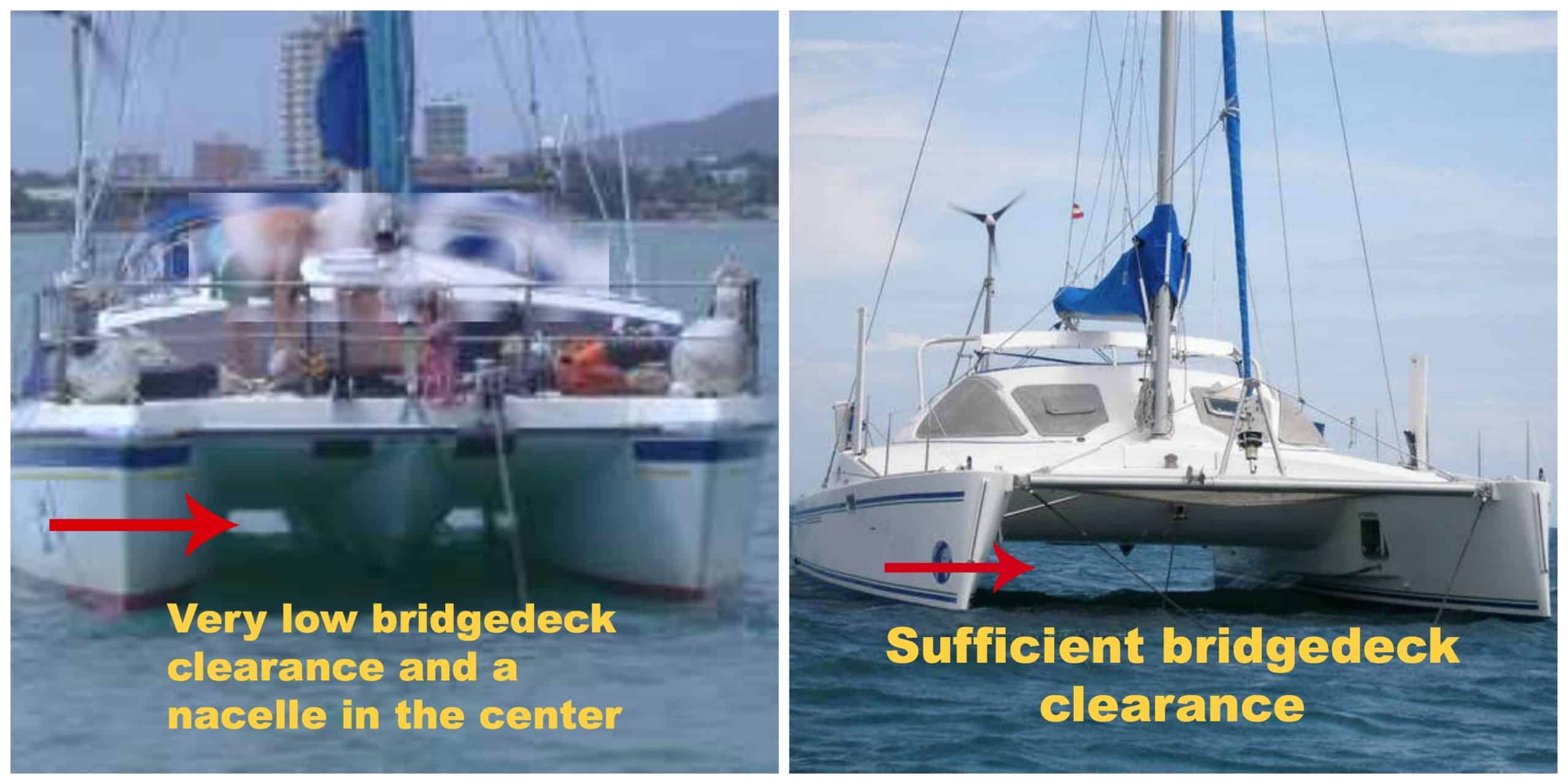
Bridge deck clearance is a key factor in predicting the slamming level of a catamaran design. A higher clearance produces less slamming. My rule of thumb is; 4% of the overall length is low, 5% is acceptable, and 6% is good.
When it comes to slamming, another important factor is weight. If the boat is heavy due to construction or payload, it will tend to go into a wave. This slams the chest of the boat into the wave. A lighter boat with more buoyancy will rise on the wave reducing slamming substantially. “ The Space Between ” by Sackville Currie, explains in detail the different options, problems, and compromises.
Windward Ability: Catamaran Keels vs. Dagger Boards

Catamarans with dagger boards are able to point much better than catamarans with keels. The claim is that a catamaran with dagger boards is safer because if the boards are up and the boat gets sideways on a wave, it will skid down the wave sideways. Dagger board proponents believe a keel trips the boat as it tries to navigate down the side of a wave causing capsize.
I can only speak from personal experience. I was caught sideways on a 20-foot wave a few days out of Cape Town on a 40ft catamaran with keels. The boat was hit by successive three waves before we could get it back on track. The boat skidded down the waves and there was no capsize, but it took some nifty maneuvering at the helm. My personal belief is that both types are safe and acceptable provided they are operated correctly.
Catamaran Deck Surfaces
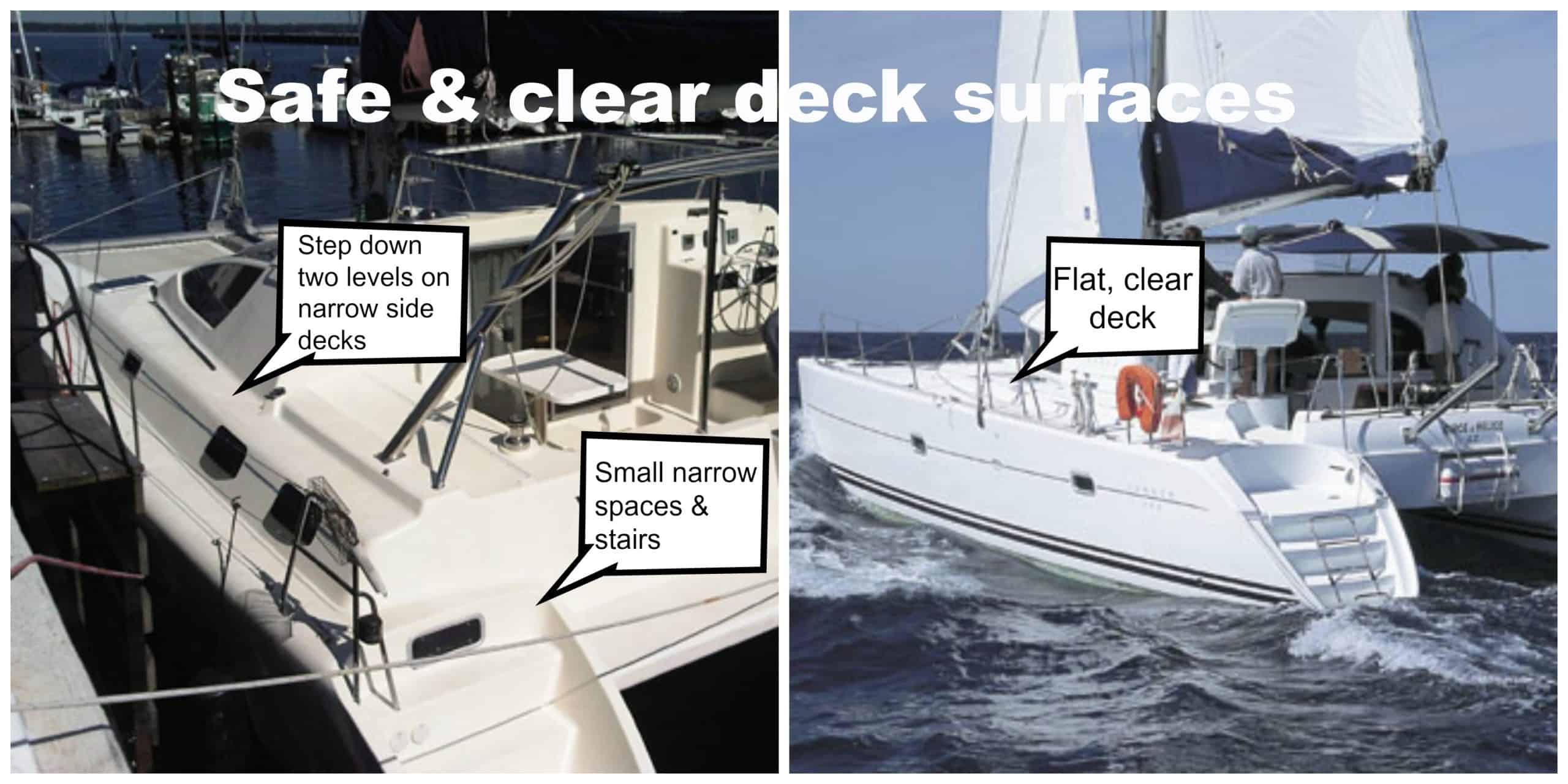
Cockpit to Mast
Older designs often have decks with two levels from the coach roof windows to the gunnels which form a side deck with a trip hazard. Most modern catamaran deck designs are now one flat surface being wide enough to walk unhindered from the cockpit to the mast.
The cockpit and the saloon should be on one level with no step down into the saloon, if possible. Modern designs have achieved this and it really makes a big difference for ease of movement and safety while at sea.
The steps on the stern should be wide and easy to climb with a reasonable angle. If the steps are too steep or narrow, they become a hazard and lose space for recreation. The stern should be easily accessible from the dinghy.
Ease of Handling: Catamaran Deck Layout

- Both jib sheets
- The sheet from the opposite side of the boat should be run through a turn block and across the coach roof through a clutch to the helm
- Jib furling line
- Single line reefing lines
- Main halyard
- Traveler control lines.
Visibility from the helm is also very important. All round visibility while underway, maneuvering, or docking is key to safety of your boat and others’ property and life. When standing at the helm, you should be able to see both bows or, at the very least, the pulpits. The center of the crossbeam where the anchor is handled from should be visible as well as both sterns for when you dock “stern to”. If all these stations are not visible while standing at the helm where the engine controls are, you may encounter problems because of blind spots.
Catamaran Characteristics Conclusion
Modern catamaran designs are much more advanced than the early models that were slower, heavier, and underpowered. Problems like hobby horsing, burying the bows, and underpowered rigs have been largely eliminated.
Even though composite construction technology gives a huge advantage in lighter materials and sleeker designs, no one design element or piece of high tech gear should dominate the vessel to the detriment of others. With some compromise, a good naval architect can design a vessel pleasing to most people and the result can be very exciting, safe, and seaworthy.
Top Tip: Use a Broker at No Cost
Which compromises should you make when selecting your catamaran? It all depends on how you will use her. Catamaran Guru helps new and veteran multihull owners select the right boat for their dreams at no cost! The yacht seller pays broker commissions so our advice from gleaned from thousands of boat-buying transactions is free to you. We will help you find right boat, the right program, or the right situation. If you want to explore more on your own, visit our buying a catamaran section.
Contact a Broker Directly
Estelle Cockcroft
Join our community.
Get the latest on catamaran news, sailing events, buying and selling tips, community happenings, webinars & seminars, and much more!
Leave a Comment Cancel Reply
Your email address will not be published. Required fields are marked *
Save my name, email, and website in this browser for the next time I comment.
Recent Posts

Exploring Paradise: Belize Sailing Vacations & Yacht Ownership
In the heart of the Caribbean lies a hidden gem waiting to be discovered

Annapolis Open House 2024
Join us at Pier 7 Marina located at 48 S River Rd South, Edgewater,


Paramount Business Jets Partners with Charter Agency!
The collaboration of Myst Yacht Charters and Paramount Business Jets offer you the most luxurious yachts
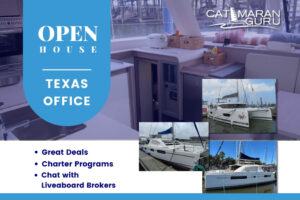
Texas Open House
Join us April 13 – 14 for our open house at our Texas office during the

For more than 30 years, we have been a part of the catamaran community and created Catamaran Guru™ to encourage and educate all the aspiring sailing out there. We understand the dream of traveling the world by catamaran and created a one-stop-shop to make that dream a reality for you.

- Stephen & Estelle
- Testimonials
Get Started
- Yacht Sales
- Used Yachts
- Charter Management
- Boat as Business Programs
- Seminars & Events

A Trusted Source For Boating Information Since 2019
Catamaran hulls- everything you need to know.
- Post Written By: Boater Jer
- Published: July 17, 2022
- Updated: July 19, 2022

Disclaimer: You might notice that we recommend products in some articles. We may earn a commission for referring you if you click the link and buy a product.
We only recommend products we’ve tried/tested/own (that’s why you won’t find thousands of affiliate links on my site). If you have experience with one of the products we’ve mentioned, please share your experiences in the comments at the end.
Advertisement

Catamaran hulls are not like normal boats but provide increased stability. Let’s take a look at these incredible boats and how their hulls create one of the most versatile watercraft available today.
The Tamil Cholas used catamarans to ferry their troops to invade Malaysia, Indonesia, and Burma. The early paravars or fishing communities in the southern part of Tamil Nadu used two-hulled boats to fish. Polynesian seafarers were also early users of the catamaran, utilizing the watercraft to get to hard-to-reach islands. ( source )
Although the catamaran hull concept is a relatively new introduction to modern boat design , the boat has been in use since the 5th century. It was used for fishing, traveling, and transporting people and supplies.
Parts Of A Catamaran
Here are the basic parts of the modern sailing catamaran:
- Hulls are what sets this boat apart from the rest. The catamaran has two hulls, while the monohull, as the name suggests, has only one hull. Most of the advantages of this boat are hinged on these two hulls.
- The bridge deck connects the two catamaran hulls.
- On top of the catamaran hulls and the bridge deck is the deck . It is where owners attach most of the equipment in a boat.
- You can locate the berth, the galley, and other living amenities in the cabin .
- The cockpit is where you find the navigation equipment of the boat . It is where you control the catamaran’s rudder, sails, and engine.
Types Of Catamaran
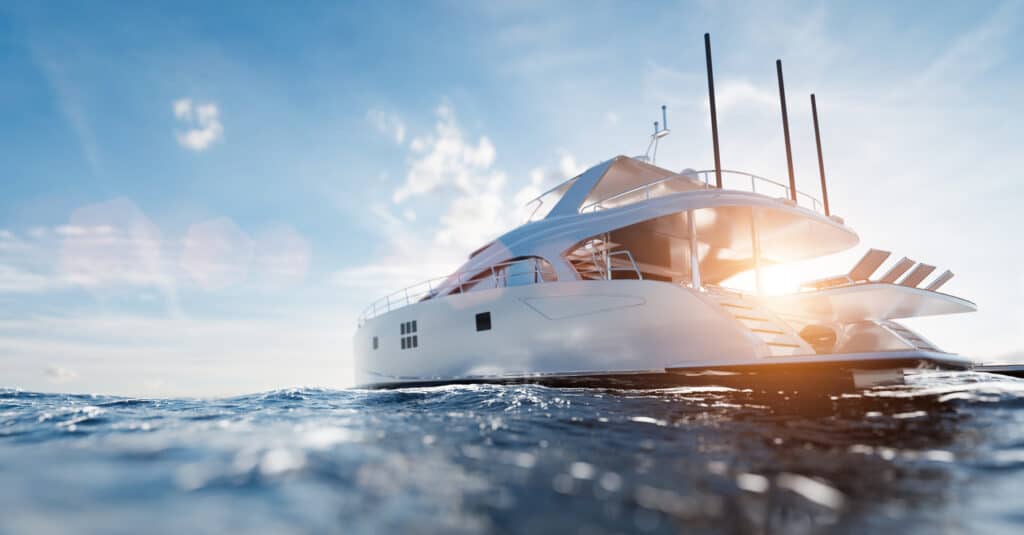
The modern catamaran is far more different than its crude ancestor. Instead of tree cutouts, catamarans are now carbon fiber or fiberglass. Here are the different types of catamarans:

Based On function
Pontoons are usually present on rivers and lakes and sometimes even on oceans, but they only travel near the shore.
In a catamaran pontoon-type boat, the pontoons serve as storage areas, where you will find the onboard motors. They are useful for water leisure activities such as short water trips, tubing, wakeboarding, and water skiing.
Some pontoons may also serve as houseboats. They provide a broader, more stable platform ideal for a floating house. Plus, the space is bigger, and most of it is above water. It offers a better viewing option than a monohull. ( Source )
Small Waterplane Area Twin Hull is a catamaran-type boat that the United States Navy initially used for military purposes. They provide the water stability that is necessary when transporting heavy military equipment.
One example of a military SWATH catamaran is the Spearhead class EPF. It is as long as a World War II escort destroyer, yet it is twice as fast at 43 knots. It can reach that speed because of its two separate hulls.
Because of their innate speed, SWATH catamarans can become patrol boats in lakes and rivers. They can easily outrun and outmaneuver standard watercraft.
Nowadays, there are SWATH cruise ships and other non-military variations. ( Source )

Based On Design
- Sailing Catamaran
The smaller sailing catamarans do not have auxiliary engines, so the owner can propel the boat by harnessing the wind using the sails. It’s a popular choice for people with very little or no sailing experience because they are light and easy to use.
The larger sailing catamarans are for group charters and long-distance cruising. They have become so popular lately that they now outnumber monohulls in tropical locations all over the world. They have a last, a headsail, and a mainsail. And the twin hulls have one engine each.
- Power Catamaran
Unlike their sailing cousins, the powered catamarans do not have sails. They have massive engines which provide high speed. Their twin hulls are stronger and can carry and protect the large motors.
The smaller “powercats” are used mainly for fishing. The bigger ones are rented out for charters and cruises.
Catamaran Hulls Performance
Thanks to the catamaran hulls, the boat offers many advantages over other boat types.
- Because its dual-hull design provides a broader base, it offers more water stability than monohull boats. It makes the cat (catamaran) a popular choice for fishing expeditions and cruises.
- Riding a catamaran is ideal for people who feel seasick whenever they ride boats. The twin hulls prevent the boat from moving from side to side. The hulls allow the boat to travel smoothly, even on moderately choppy waters.
- The catamaran is the best choice when storing provisions and other household items with less heeling and bobbing.
- The twin hulls’ stability is ideal for many activities such as cooking and partying.
- Cats offer more moving space because of their broader base, thanks to dual hulls.
- With a catamaran, you have two great options on where to hang out. You can do it on the spacious deck or below the galley.
- Compared to a monohull of the same size, the catamaran can accommodate more equipment and people.
- The living area in a catamaran is above the water line. This feature provides more natural light, a greater view of the outside, and better air circulation.
- Since catamarans do not have keels, they can anchor on shallow waters, something that most monohulls will not be able to do. This ability of catamaran boats is impressive, especially if you are going around areas with many reefs and small islands.
- Catamaran hulls allow the boat to cut through the waves easier and faster. It means they require less engine power than their monohull counterparts.
- Because it has two engines and two rudders, the catamaran can easily maneuver in very tight spaces.
- Because they do not carry heavy keels, catamarans can sail faster than monohulls.
- The catamaran’s stability, speed, and weight make it a safer option than the monohull. It can sail in shallow waters, make a 360 degrees maneuver effortlessly, and carry more provisions.
Disadvantages Of A Catamaran
Like any other boat type, the catamaran also has drawbacks and limitations. Here are some of them:
- The catamaran hulls prevent the boat from sailing as fast as the monohull upwind. The two hulls cause drag, and this slows the boat considerably.
- Because of its bigger size, looking for a docking site can be more difficult and costlier than a monohull.
- For hardcore sailing fans, the experience of sailing with a catamaran will never be able to match that of sailing with a monohull. To them, the challenge of true sailing is just not there with a catamaran.
What Are The Hulls Of The Catamaran Called?
According to the Online Etymology Dictionary, the Tamil word கட்டுமரம், which is pronounced as kattumaran, is where the word catamaran takes its name. The word means “pieces of logs tied together”. Through the years, the term has evolved into what is now a catamaran in English.

What Are The Characteristics Of A Catamaran Hull?
- Both hulls of a catamaran complement each other to achieve very minimum water resistance.
- Because of this, it takes less energy to propel a catamaran, whether via an engine or sails.
- The catamaran hulls provide stability to the boat. The twin-hull significantly reduces bobbing.
- The catamaran’s ability to keep steady on the water makes it an ideal vessel for cooking, dining, and storing provisions.
Are Catamarans Good In Rough Water?
Catamarans are amazingly stable in rough water. The catamaran’s design and build, which provides stability, are factors why it is one of the best boats to use when the waters are choppy.
Yes, catamarans are relatively more expensive than monohulls. Nevertheless, since single-hull boats are less expensive, their resale value is also cheap.
If you add all the advantages that a catamaran offers – safety, comfort, and speed- it does not come out expensive.
patekphilippe.io

Share this post with your friends
Subscribe to our newsletter.
Join us in our love for all things water. And Adventure.

How Long Does A Kayak Last? 5 Awesome Materials Examined
Advertisement If you’re wondering: “How long does a kayak last?” you’ve come to the right place for answers about kayaks of various materials. Kayaks and canoes are expensive things. Some cost hundreds of dollars, so it is understandable to want your investment to last for a lengthy period. Some investigation is required to establish the

Are Ranger Boats Worth The Money? (We Find Out)
Advertisement Many people consider boats to be a luxury item, and some of the costs involved when buying a boat tend to support that paradigm. Ranger boats are a trendy brand in the Us boating fraternity, and they can sometimes demand a high price compared to other boats. Is the price for Ranger boats justified,

Before You Buy Guide: Understanding Fish Finders And GPS
Advertisement There’s nothing more relaxing than a day out on the water. The gentle movement of the boat, the sun, and breeze moving over the water. These things make it hard to want to ever go back to civilization. And catching a few big fish sure would be the icing on the day’s cake. There’s

An Easy Boat Repair Guide To Painting Over Gelcoat
Advertisement A Boat Repair Guide To Painting Over Gelcoat (aka Gel Coat) Paint is an essential part of boat repair, enhancing the overall look and helping seal the hull. Painting over the gel coat is good because the gelcoat acts as an adhesive for the paint to stay in the place. However, you will have

Best Cruising Catamarans For Couples
Advertisement Looking for the best cruising catamarans for couples? Are you looking for the best spot to spend your holiday as a couple? If you want to spend a little time with someone you care about, keep reading because you are in the right place. Among the well-known cruising catamaran patronized by couples is the

Boat Repair- The Truth About Eisenglass Vs. Vinyl
Advertisement If you’re a boat owner, you must have come across eisenglass vs. vinyl. Yes, they’re world-famous materials used to make clear glass windows. Since they’re thin strips and durable, they don’t take up much space in the boat. However, when repairing the vessel, you might want to reconsider whether to install eisenglass or vinyl.

Boat Information By Type
© 2023 Boating.Guide, A Hyperwave Media Group Ltd. Publication.
Privacy Overview
Yachting World
- Digital Edition

Why do keel failures happen and what can we do to prevent it?
- Matthew Sheahan
- June 10, 2017
We investigate the causes of keel failures and find some worrying reports of near-misses
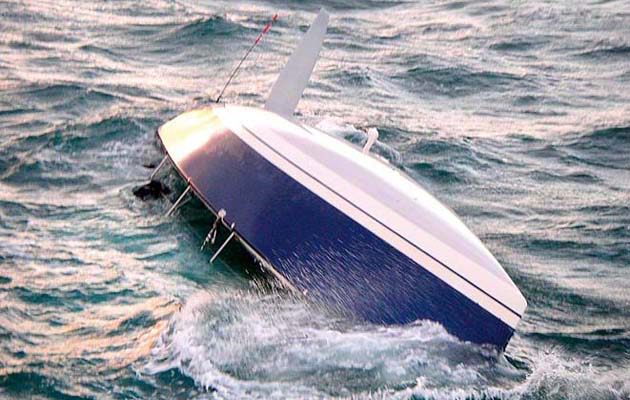
Keel damage is a very real danger
To contemplate the loss of your keel is to think the unthinkable. Yet in recent years there have been several cases that have reminded us that this worst-case scenario can and does happen.
Many of the recent incidents have been aboard raceboats, often fitted with high-performance keels that push the boundaries of design and technology.
But the loss of the keel aboard Cheeki Rafiki, which became the subject of an intensive search last year, sent shockwaves through the sport. This was a standard Beneteau 40.7, a boat that is anything but high-tech. With around 800 afloat, it is a modest design with a reputation for being a robust and reliable workhorse.
Furthermore, the 40.7 is not only popular, but is typical of many other cruiser-racer styles around the world. Far from being extreme, this was a tragedy that claimed four lives aboard a run-of-the-mill cruiser-racer and struck a chord with thousands of sailors.
It wasn’t the first case of its type, however. In May 2013 a Bavaria 390 lost her keel 650nm north-east of Bermuda while on passage back from St Maarten to the Azores. In this incident the two-man Danish crew were rescued from a liferaft by a Finnish navy ship.
Before that there was the case of Hooligan V, a production raceboat that lost her keel in 2007 and claimed a life. In 2005 a Bavaria Match 42 lost hers as the internal structure pulled through the bottom of the boat. In the same year Moquini, a Fast 42, lost her keel off South Africa with the loss of six crew.
Indeed, so concerned is the sport’s governing body, ISAF, about the incidences of keel failure that it has formed a Keel Structure Working Party to investigate the issue. Part of the group’s initial work was to develop a database of the reported failures. Currently, the list includes 72 cases since 1984, and in those 24 lives have been lost – a small number perhaps when compared with the many thousands of boats that have been built over this period, but unacceptable nonetheless.
The trouble is that these are only cases where the worst has happened and the keel has parted company with the boat. It is frequently difficult to establish the cause of failure, and particularly to separate a shortcoming in design or manufacture from a human error such as a grounding. In a world where online forums spread gossip and rumour at the click of a mouse, getting to the truth can be especially tricky.
Next: Damage to your keel when you go aground
- 1. Introduction
- 4. If you enjoyed this….
- New Sailboats
- Sailboats 21-30ft
- Sailboats 31-35ft
- Sailboats 36-40ft
- Sailboats Over 40ft
- Sailboats Under 21feet
- used_sailboats
- Apps and Computer Programs
- Communications
- Fishfinders
- Handheld Electronics
- Plotters MFDS Rradar
- Wind, Speed & Depth Instruments
- Anchoring Mooring
- Running Rigging
- Sails Canvas
- Standing Rigging
- Diesel Engines
- Off Grid Energy
- Cleaning Waxing
- DIY Projects
- Repair, Tools & Materials
- Spare Parts
- Tools & Gadgets
- Cabin Comfort
- Ventilation
- Footwear Apparel
- Foul Weather Gear
- Mailport & PS Advisor
- Inside Practical Sailor Blog
- Activate My Web Access
- Reset Password
- Customer Service

- Free Newsletter

Pearson Rhodes 41/Rhodes Bounty II Used Sailboat Review

Hallberg Rassy 42 Used Sailboat Review

How to Perform Your Own Pre-Buy Inspection

Beneteau 323 Used Boat Review

How Does the Gulf Stream Influence our Weather?

Can You Run a Marine Air-Conditioner on Battery Power?

Preparing Yourself for Solo Sailing

Your New Feature-Packed VHF Radio

Practical Sailor Classic: The Load on Your Rode

Anchor Rodes for Smaller Sailboats

Ground Tackle Inspection Tips

Shoe Goo II Excels for Quick Sail Repairs

What Oil Analysis Reveals About Your Engine

An Unusual Sailboat Shines a Light On A Sustainable Future

Is It Time to Get an Electric Dinghy Motor?

Bottom Paint 30-Month Update

Battle of the Teak Cleaners — Snappy Teak-Nu vs. Star Brite

New Seacocks for the Offshore Sailor

Bottom Paint Care

Are E-bikes Worth the Extra Weight and Cost?

How to Handle the Head

How to Select Crew for a Passage or Delivery

Preparing A Boat to Sail Solo

Re-sealing the Seams on Waterproof Fabrics

Waxing and Polishing Your Boat

Reducing Engine Room Noise

Tricks and Tips to Forming Do-it-yourself Rigging Terminals

Marine Toilet Maintenance Tips

Learning to Live with Plastic Boat Bits
- Boat Maintenance
Keels: Minor Maintenance and Repair
Remedies for rusty iron keels.

The best way to treat an iron keel that’s rusting is to sandblast the whole thing and apply a complete, new, epoxy-based coating system. But that’s not always feasible or desirable. Because of the mess involved, many boat yards do not allow sandblasting. Even when this is permissable, a complete recoating job also means a complete re-fairing job, and that in turn means lots and lots and lots of slow, boring, dirty work if anything approaching a proper, smooth foil is to be achieved.

Because of the problems involved in complete refinishing of an iron keel, patch painting of rusted spots is often the only practical way to go.
Begin by cleaning the rusted spots as thoroughly as possible. Take your time here as this is the most important step. Chip off any scale with a cold chisel or welder’s chipping hammer, then wire brush-use a drill-powered brush where possible – and sand with coarse paper until you’re down to clean, bright iron. Use fine sandpaper (#150) to feather in surrounding, sound paint, and you’re ready for your new coating. Get paint on the bare, prepared iron as soon as possible. Iron will begin to oxidize almost immediately, and leaving it bare overnight will make much of your preparation go for naught.
Unfortunately, the best possible anti-rust coatings – those with epoxy bases which are true vapor barriers – are not compatible with other paints. Epoxies just won’t stick to other coatings; and, thus, because patch painting must lap over onto other paint, epoxies can’t be used in this application.
Our own experience backs up the recommendations of the paint manufacturers. The best coating to use in patch painting iron is zinc chromate paint. All the major manufacturers of marine coatings make a good zinc chromate. Take your choice and follow the directions. The most important rule to follow is three coats must be used. The object is to form as nearly an impenetrable barrier to water as possible, and three coats give a far better chance than one or two.
Patch painting isn’t the ultimate answer. Actually the ultimate solution isn’t even the sandblast – epoxy route. It’s replacing the damned iron with lead. But that’s even less economically feasible than sandblasting! Careful preparation and three coats of zinc chromate paint, however, make for a good, economically and manpower effective, finite solution.
-John Pazereskis
As a rule, lead keels require far less care than iron. Nevertheless, they are not maintenance free. While you don’t normally think of your lead keel as corroding away, lead keels can develop significant problems that both degrade performance and reduce the value of your boat.
The main culprit is bottom paints with a high copper content. Copper paint on a lead keel creates a galvanic couple, just as copper paint does on an iron keel. Fortunately, the difference in potential between lead and copper is far less than the difference between iron and copper, so that corrosion problems are commensurately smaller.

However, it is common to see lead keels with crumbly, whitish surface deposits, which when scraped away reveal a porous surface where the lead has corroded. Fortunately, the surface of a lead keel does not corrode and pit in the same manner as an iron keel, and reasonable repairs can be made without expensive equipment.
A drill-powered wire brush will usually grind away surface deposits and do an adequate job of cleaning out shallow corroded areas. It is important to remove as much of the crumbly oxidized lead as possible, to create a good surface for filler bonding.
With the lead clean and bright, fill corroded areas immediately with an epoxy filler. The best epoxy fillers for this purpose are the ones you make yourself from epoxy resin, such as the Gougeon Brothers West System epoxy, and a filler such as phenolic microballoons or microspheres. Remember that lead is pretty soft, and you don’t want your filler to be significantly harder than the surrounding material.
When filling, give the area to be faired a prime coat of unfilled epoxy before applying the thickened epoxy mixture. This will allow a better bond between the filler and the surface. You can allow the clear epoxy to partially kick off before over-coating with filler, but don’t let it cure completely or you’ll get a poor bond.
When the filler has cured, sand or plane it level and smooth. A belt sander or conventional hand bench plane can be used, since lead planes almost as easily as wood.
With all corroded areas and damaged areas cleaned and filled, sand or wire brush the rest of the keel to bright metal. A belt sander or disc sander works fine here, although proper use of either tool to avoid gouging the surface takes a little practice. A lead keel is far easier to bring to bright metal than an iron keel. The fin keel of a 30-footer can be done in an hour or so.
To make sure your keel doesn’t begin to corrode again, you must completely isolate the surface of the keel from the bottom paint with an epoxy barrier.
This is a two-stage process. First, the keel must be primed with a vinyl primer, such as Regatta Vinyltex 50/51 or Interlux Viny-Lux Primewash 353. The primed keel can then be over-coated with an epoxy mastic such as Regatta Epoxydur Mastic 3630-3631. Surface preparation and the timing of application of the coats of vinylepoxy systems are critical, so the manufacturer’s instructions must be followed to the letter.
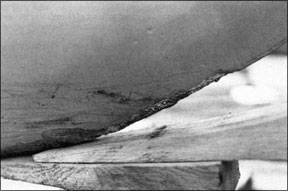
The epoxy mastic coating does not sand well, so special care must be taken in application to get a smooth keel surface. This same epoxy system can be used on iron keels that have been blasted or ground to bright metal, but is only effective on a completely clean surface free of any rust or scale.
Several coats of the epoxy mastic can be used. The thicker the coating, the more effective the barrier between the keel.
The only drawback of epoxy sealing of an external keel is that it no longer functions as a good ground plane for Loran and single sideband, or as access to ground in a lightning protection system. To compensate, you should install an external grounding plate such as the Dynaplate.
Surface corrosion is not limited to the lead keels on older boats. Poorly alloyed keels on new boats can also corrode. Fortunately, the cure is not difficult – only labor intensive – and the prognosis is for complete recovery and a long life. Yearly checkups are recommended, with local retreatment as necessary.
Beauty of Internal Ballast Really Is Skin Deep
If you’re gloating because you think your encapsulated keel frees you from any worries, forget it. Encapsulated ballast frequently requires more complicated care than an external ballast keel.
The danger is damage to the fiberglass shell surrounding the keel.
Even if you haven’t run aground this year, there’s a good chance that some where along the way you have acquired at least some superficial gouges in the lower part of the keel shell. These should be treated before they become problems. Even superficial damage to the gelcoat can allow water penetration into the laminate.
Treatment of superficial gouges in gelcoat or the first layers of the laminate is straightforward. First, wash the damaged area thoroughly with high pressure fresh water. Dry the gouged area with a handheld hair dryer. Roughen the edges of the gouge with very course sandpaper – 50 grit or 36 grit.
Wash the area again thoroughly with acetone. Use a small, stiff bristle brush to clean the gouge completely. Dry again with the hair dryer, after most of the acetone has flashed off. Don’t breathe the stuff.
With the area thoroughly clean and dry, brush on a clear coat of epoxy resin, followed by resin thickened with microspheres or micro-balloons. Stick waxed paper over the epoxy patch to keep the epoxy from sagging out.
When it’s dry, sand smooth and touch up any voids or hollows with more filled epoxy.
When everything is filled, prime the patch and the surrounding area with a two part epoxy primer, such as Woolsey MFP. This is important, because the gelcoat that you have sanded is now pretty porous, and is more likely to develop blisters than polished gelcoat.
More extensive damage to encapsulated keels, requiring structural fiberglass repair, will be dealt with in another article. How do you tell if you’ve got structural damage? As a rule, any time the shell is ground away so that any of the ballast is exposed, or any time laminate is exposed over an area’ greater than a square foot, you probably need to do more than patch with putty.
RELATED ARTICLES MORE FROM AUTHOR
Leave a reply cancel reply.
Log in to leave a comment
Latest Videos
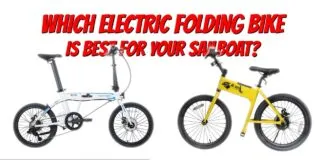
What Is The Best Folding Bike For Your Sailboat?

The No Expense Spared Antigua 60 Cruising Sailboat Soolaimon

How To Buy Sails – With Joe Cooper

Bavaria C42: What You Should Know | Boat Tour
- Privacy Policy
- Do Not Sell My Personal Information
- Online Account Activation
- Privacy Manager
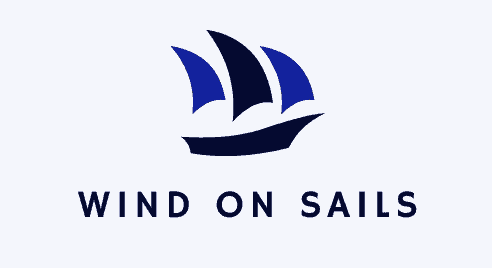
Keelboat Sailing 101: A Beginner’s Guide to Navigating the Seas with Stability
- May 20, 2023
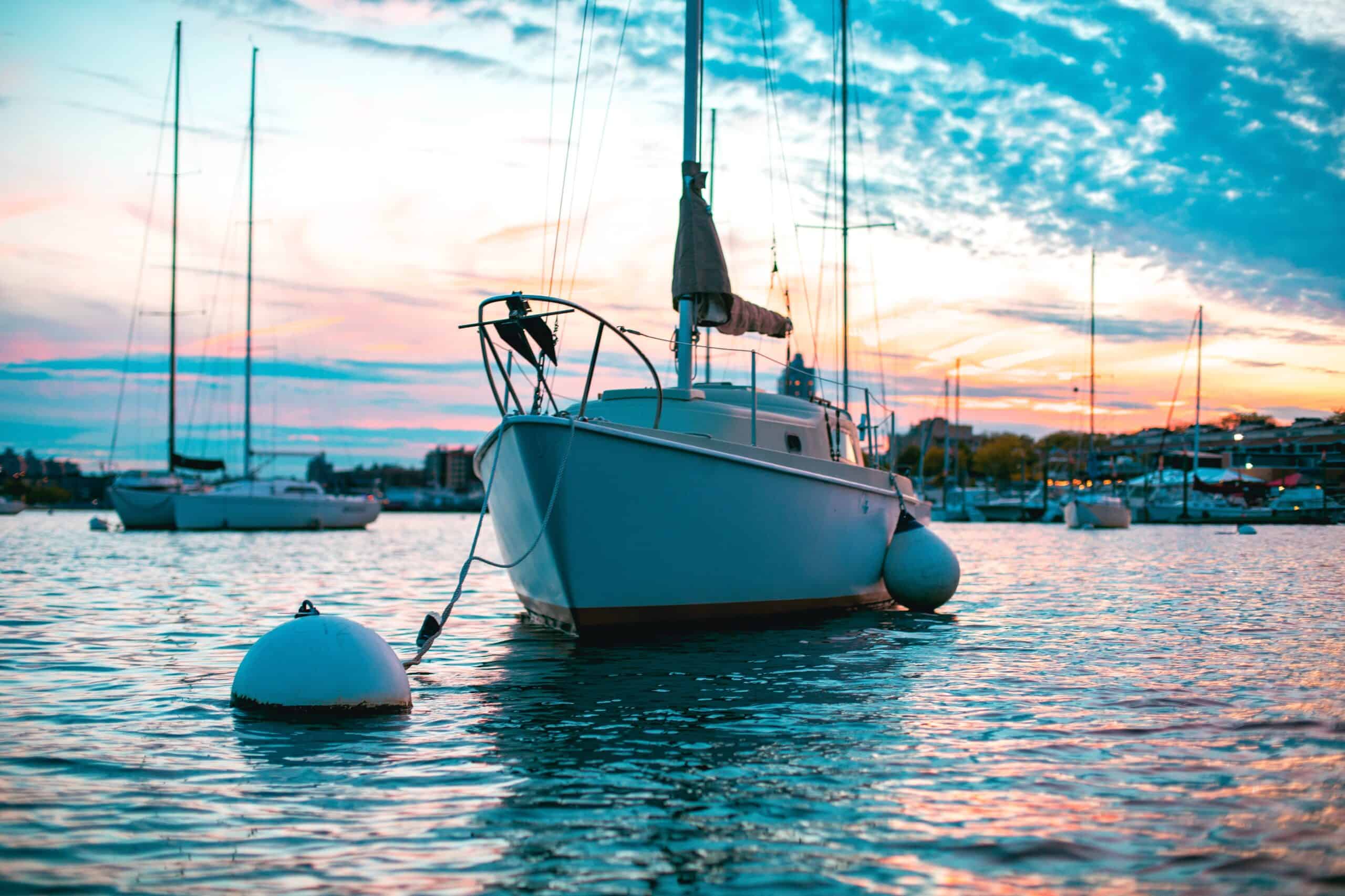
Ahoy, aspiring sailors! If you’re ready to embark on a thrilling adventure on the open waters, keelboat sailing is the perfect choice for you. In this beginner’s guide, we’ll delve into the world of keelboat sailing, uncovering the wonders of this stable and versatile vessel. Join us as we set sail and discover the exhilaration of keelboat sailing!
Table of Contents
Understanding keelboats.
Keelboats are sailing vessels renowned for their stability and maneuverability. Unlike dinghies or catamarans, keelboats feature a weighted keel beneath the hull, providing balance and resistance against heeling. Familiarize yourself with the anatomy of a keelboat, including the hull, rigging, and keel types, to gain a deeper understanding of this remarkable vessel.
Essential Equipment for Keelboat Sailing
Before embarking on your keelboat sailing adventure, ensure you have the necessary equipment on board. These may include life jackets, marine VHF radio, navigation tools like charts and compasses, and safety gear such as flares and first aid kits. Additionally, pack appropriate clothing, sun protection, and essential sailing gear. Safety should always be your top priority, so familiarize yourself with safety procedures and guidelines.
Basic Keelboat Sailing Techniques
Keelboats offer excellent stability, making them ideal for beginners. Start by learning fundamental sailing techniques such as hoisting and trimming sails, steering, and tacking. Understand the role of the keel in maintaining stability and how to adjust it as needed. As you gain confidence, you can progress to more advanced techniques like gybing, sail trim, and optimizing boat speed.
Navigating with Keelboats: Wind, Tides, and Currents
Understanding the interaction between wind, tides, and currents is essential for successful keelboat sailing. Learn to read wind patterns, anticipate changes, and adjust your sails accordingly. Familiarize yourself with tidal charts and how currents can influence your course. Mastering navigation skills will enable you to plan your journeys effectively and make the most of your keelboat sailing experience.
Keelboat Maintenance and Care
To ensure the longevity and performance of your keelboat, regular maintenance is vital. Learn how to inspect the rigging, check for wear and tear, and perform routine maintenance tasks. Keep the hull clean and protected, and pay attention to the keel and its components. Storing the keelboat properly during offseasons or when not in use is also crucial. By taking care of your keelboat, you’ll enhance safety and enjoyment on the water.
Joining Keelboat Sailing Communities
Connecting with fellow keelboat enthusiasts is a fantastic way to learn, share experiences, and expand your skills. Join local sailing clubs or online communities dedicated to keelboat sailing. Engage in races, regattas, or organized cruising events to challenge yourself and grow as a sailor. The knowledge and camaraderie gained from these communities will enhance your keelboat sailing journey.
Congratulations! You are now equipped with the essential knowledge to begin your journey towards a keelboat sailing adventure. From understanding the dynamics of keelboats to mastering basic sailing techniques, and from navigating with confidence to maintaining your vessel, this beginner’s guide has set you on a course for exciting experiences on the water.
So, hoist your sails, trim them for optimal performance, and set forth on your keelboat sailing voyage. Discover the joy of sailing with stability and embrace the endless possibilities that keelboat sailing has to offer!
Related Posts
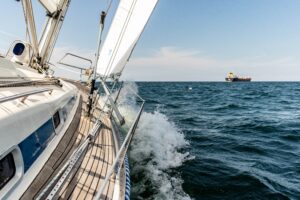
Understanding the Parts of a Sailboat: A Comprehensive Guide to Sailboat Anatomy in 2023
- June 10, 2023

Exploring the Different Types of Sailboats and Their Versatile Uses
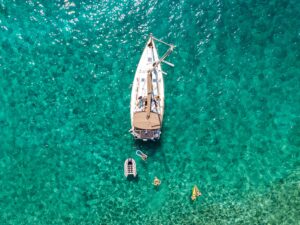
Yacht Sailing 101: A Beginner’s Guide to Embarking on Luxurious Adventures
Log in or Sign up
You are using an out of date browser. It may not display this or other websites correctly. You should upgrade or use an alternative browser .
looking for used sailmaking plotter
Discussion in ' Sailboats ' started by Sergey , Feb 24, 2002 .
Sergey New Member
Hello! We are a company working in a field of tensile fabric structures in Moscow, Russia. We are looking for a used plotter (we can`t afford a new one yet) ProSail or ORION (A-frame single rail type) by Blackman and White of 2000mm width, that could be mounted to the existing table of 20m long. Or something just alike to mark patterns on matrial itself. Sometimes we use the ProSail plotter at PARAAVIS workshopshttp://www.paraavis.com. But it is not our own plotter and it is only 1620mm wide. We are closely working as POLYTENT with WALTER GROUP (lightweight structures) and FERRARI (PVC-coated fabrics) in France. We`ll be thankful for any information on where, how to get it, how much... Best regards. Sergey Nikitin. Technical director. www.tent-lsk.ru
Attached Files:
Stephen Ditmore Senior Member
I'm afraid I can't help with the plotter problem, but let me run an idea past you. I've been wondering whether you could use a tortured plywood method similar to that used at http://www.by-the-sea.com/stillwaterboats/ to build multihulls. I see it being analogous to sailmaking; you could use a sailmaking program to shape each piece of plywood like a sailmaker shapes panels of sailcloth, giving each edge some curvature before scarfing them together. Plywood here in the U.S. comes in 4'x8' sheets, and I think the international standard is similar. To build a 40' catamaran I'm thinking one could shape the long edges and then scarf them together, so that their long dimension would run keel to sheer. You could either assemble them there in Moscow or sell precut panels that could be assembled anywhere in the world (note also that high quality composite panels can be purchased from http://www.atlcomposites.com/products_composite_duflex_intro.htm ). http://www.geocities.com/dumchikov/bio_design/ appears to be the web site of a Ukrainian multihull designer. If you were to build some multihulls to his designs, whether using my method or another, I'd be interested in marketing them in the United States.
Looking for love or hate. Give me your opinions on this design
Ranger 30 - looking to summer on it and sail it intercostal and maybe some blue water
CLC PocketShip, Schreyer CROW, or ... ? Looking at home builts < 16'
Looking at a Catalina 30
Looking for a sail-motor dinghy 5-5.5 m
Looking for free (but hopefully informed) advice on maximum reasonable boom length
looking for info on this boat
Looking for MORC 1/4 Toner - Whisper
Looking for something different
Looking for a daggerboard for MFG Sidewinder.
- No, create an account now.
- Yes, my password is:
- Forgot your password?

- Скидки дня
- Справка и помощь
- Адрес доставки Идет загрузка... Ошибка: повторите попытку ОК
- Продажи
- Список отслеживания Развернуть список отслеживаемых товаров Идет загрузка... Войдите в систему , чтобы просмотреть свои сведения о пользователе
- Краткий обзор
- Недавно просмотренные
- Ставки/предложения
- Список отслеживания
- История покупок
- Купить опять
- Объявления о товарах
- Сохраненные запросы поиска
- Сохраненные продавцы
- Сообщения
- Уведомление
- Развернуть корзину Идет загрузка... Произошла ошибка. Чтобы узнать подробнее, посмотрите корзину.
Oops! Looks like we're having trouble connecting to our server.
Refresh your browser window to try again.

IMAGES
VIDEO
COMMENTS
The boat with a fixed keel is likely to point nearly as high as one with dagger boards, but will lose ground though increased leeway. As the wind strength increases the fixed keels will typically operate much more efficiently and from personal experience the difference in performance between two similar cats -one with efficient fixed keels, the ...
Good directional stability depends on the hull balance. A properly designed daggerboarded boat will sail as straight as a LAR keel one, and have the additional benefit of being quicker to tack and maneuver when necessary. Finally, if you run aground, you can lift the boards to get off, but remain stuck with keels.
In short, the lack of a keel on catamarans is one of the main advantages of the design. The two hulls provide greater stability and maneuverability, and the overall lighter weight of the boat makes it easier to transport and launch. The lack of a keel also makes the catamaran more fuel efficient and responsive to the waves and wind.
The Rustler 57 has the option of being fitted with a lifting keel. Its 2.0 (6ft 8in draft makes her a more versatile cruising yacht. In the centre of the keel is a bronze fin that has a chord as wide as the depth of the lead stub. When the blade is retracted, the yacht only draws 2.0m / 6ft 8in and she still sails well.
Catana 39 Underbody - No keel but daggerboards. You could essentially say that a catamaran with keels is a bit like a long-keel monohull, and the daggerboard catamaran is a fin keel monohull in more terms. I think we all know and all agree that the best sailing boats are going to be the one with fin keels.
A full keel runs from end to end of the boat lengthways. A full keel, as the name implies, runs almost the entire length of the boat. At a minimum, it must run 50% of the length of the boat. A full keel is one of the most stable keel types, which is why it is so common. Full keels are also safer should you run aground.
Even keel catamarans can surf at speeds up to 30 knots down large seas. Upwind Advantages: Depending on sea state going upwind, daggerboard catamarans vs. their keel relatives will point up to 5 degrees higher and also experience 2-5 degrees less leeway, which isn't much one would think. But in an uncomfortable 100 mile beat this ads up to ...
The most common sailboat keel types are full-length keels, fin keels, bulb keels, wing keels, bilge keels, and lifting keels. Full keels are popular among cruisers, while fin keels are generally used for racing. Bilge keels and lifting keels are typically used in tidal waters, on small fishing boats for example.
See the basic idea of how the sacrificial mini keels on the Fountaine Pajot sailing catamaran range work to provide a safe and stable platform when beaching ...
Having a catamaran with daggerboards means enjoying better pointing ability than an equivalent model equipped with fixed stub keels, which are inevitably shorter. It means that you can also optimize drag, speed and even safety. Partially integrated, with foils...an inventory of the daggerboards on our boats and how to use these appendages.
When owners understand the repercussions of choosing a lifting keel yacht, many of them feel it restricts their options too much. They could have a lifting keel or they can sail with twin keels, dry out, have better close-quarters handling and save money in the process. Unless you need the shallowest possible draught - 0.75m (2ft 5in) on the ...
The length of the stub keel will depend on various factors, such as the size and design of the catamaran, intended use, and specific requirements of the boat builder. Generally, the stub keel on a catamaran is designed to provide stability and improve sailing performance, so it is important to consult with a naval architect or boat designer to ...
By: Phillip Berman, published with editor's permission from Boating NZ and Blue Water Sailing In my forty-five year career in the catamaran industry there's been a relentless debate on the virtues and vices of daggerboards versus fixed keels. This debate has, however, mostly been waged without "hard numbers" from which to compare performance differences. As we […]
STABILITY: Unlike monohulls that rely on a heavy lead keel to keep it upright, a catamaran relies on the beam of the boat and the buoyancy of the hulls for stability. Typically cruising catamarans will have a beam to length ratio of roughly 50%. So a 45-ft long catamaran will be about 22-ft wide, providing a very stable platform.
Catamarans don't coast well primarily because they don't have a deep keel to track. Relying on coasting to a dock at a shallow angle and then going into reverse and using prop walk to cozy up the stern won't work. It is better to come in at a sharper angle and then pivot the boat into position with the engines.
Hulls are what sets this boat apart from the rest. The catamaran has two hulls, while the monohull, as the name suggests, has only one hull. Most of the advantages of this boat are hinged on these two hulls. The bridge deck connects the two catamaran hulls. On top of the catamaran hulls and the bridge deck is the deck.
Before that there was the case of Hooligan V, a production raceboat that lost her keel in 2007 and claimed a life. In 2005 a Bavaria Match 42 lost hers as the internal structure pulled through the ...
First, the keel must be primed with a vinyl primer, such as Regatta Vinyltex 50/51 or Interlux Viny-Lux Primewash 353. The primed keel can then be over-coated with an epoxy mastic such as Regatta Epoxydur Mastic 3630-3631. Surface preparation and the timing of application of the coats of vinylepoxy systems are critical, so the manufacturer's ...
Keelboats are sailing vessels renowned for their stability and maneuverability. Unlike dinghies or catamarans, keelboats feature a weighted keel beneath the hull, providing balance and resistance against heeling. Familiarize yourself with the anatomy of a keelboat, including the hull, rigging, and keel types, to gain a deeper understanding of ...
To build a 40' catamaran I'm thinking one could shape the long edges and then scarf them together, so that their long dimension would run keel to sheer. You could either assemble them there in Moscow or sell precut panels that could be assembled anywhere in the world (note also that high quality composite panels can be purchased from ...
Find many great new & used options and get the best deals for 1978 1980 Olympics Moscow Keel Yachts Catamaran Tornado RUSSIA USSR B84 CTO at the best online prices at eBay! Free shipping for many products!
Russia B 84, MNH. Olympics Moscow-1980, Keel Yachts, Catamaran Tornado.
Guppy 13 sailboat for sale. The Guppy is a fiberglass boat with a shoal draft keel, and sleeps 2 adults in a 6 ft 8 in long cabin. LOA 12'6". Beam 5'7". Displacement 480 lb empty with 150 lb of ballast. Draft 1'7". It has a Bermuda rig consisting of a 32 square feet high aspect main sail and a 48 square feet jib.